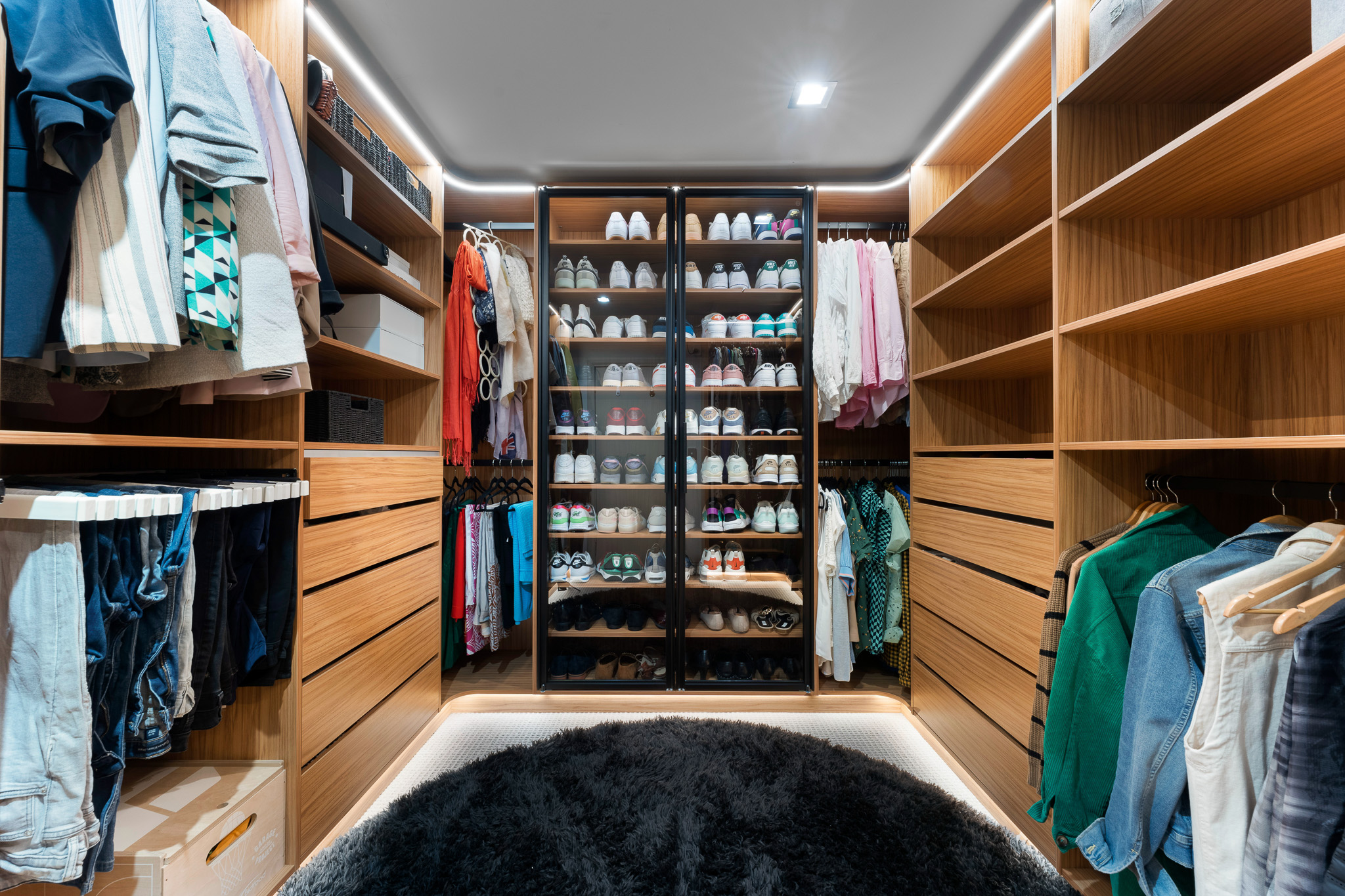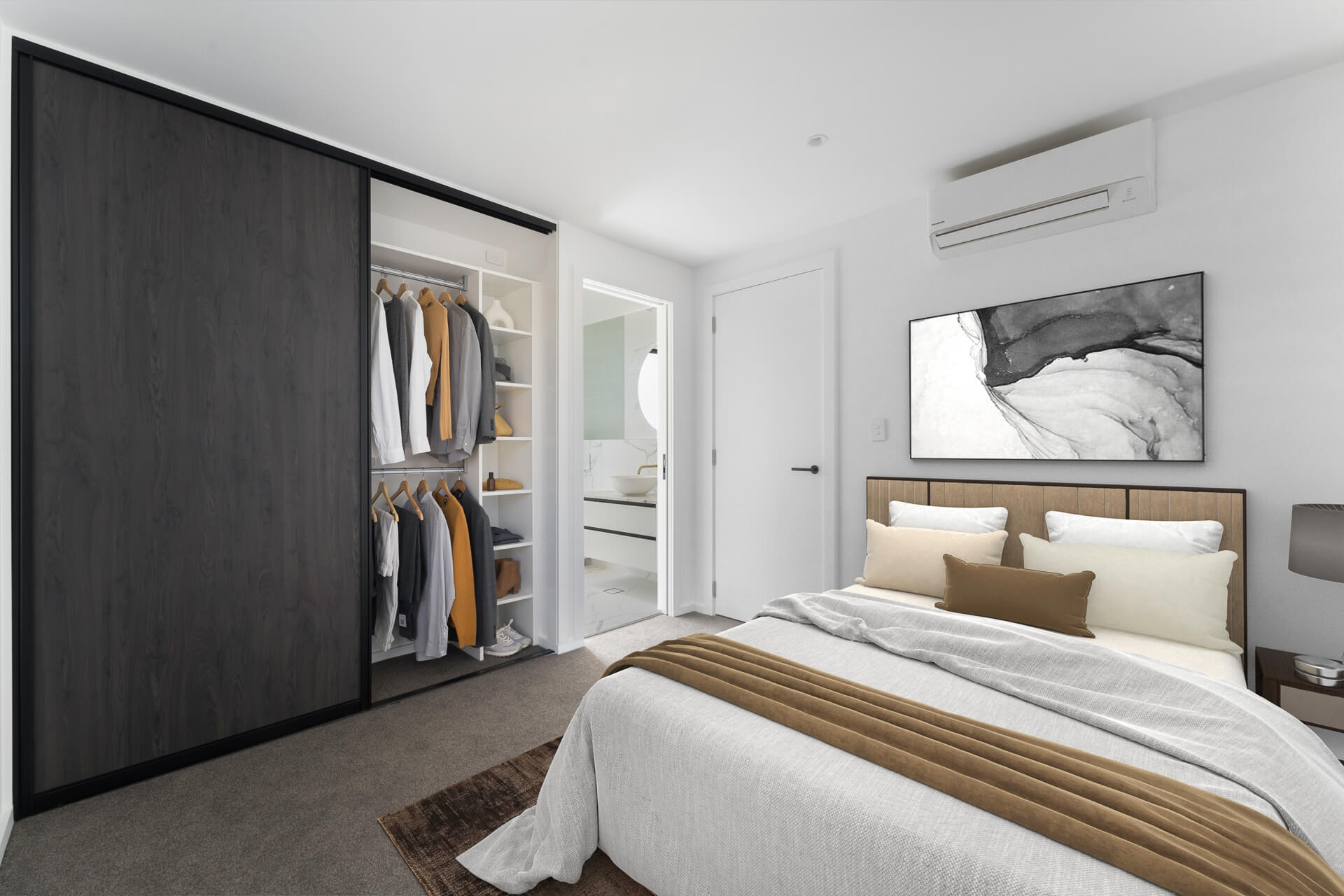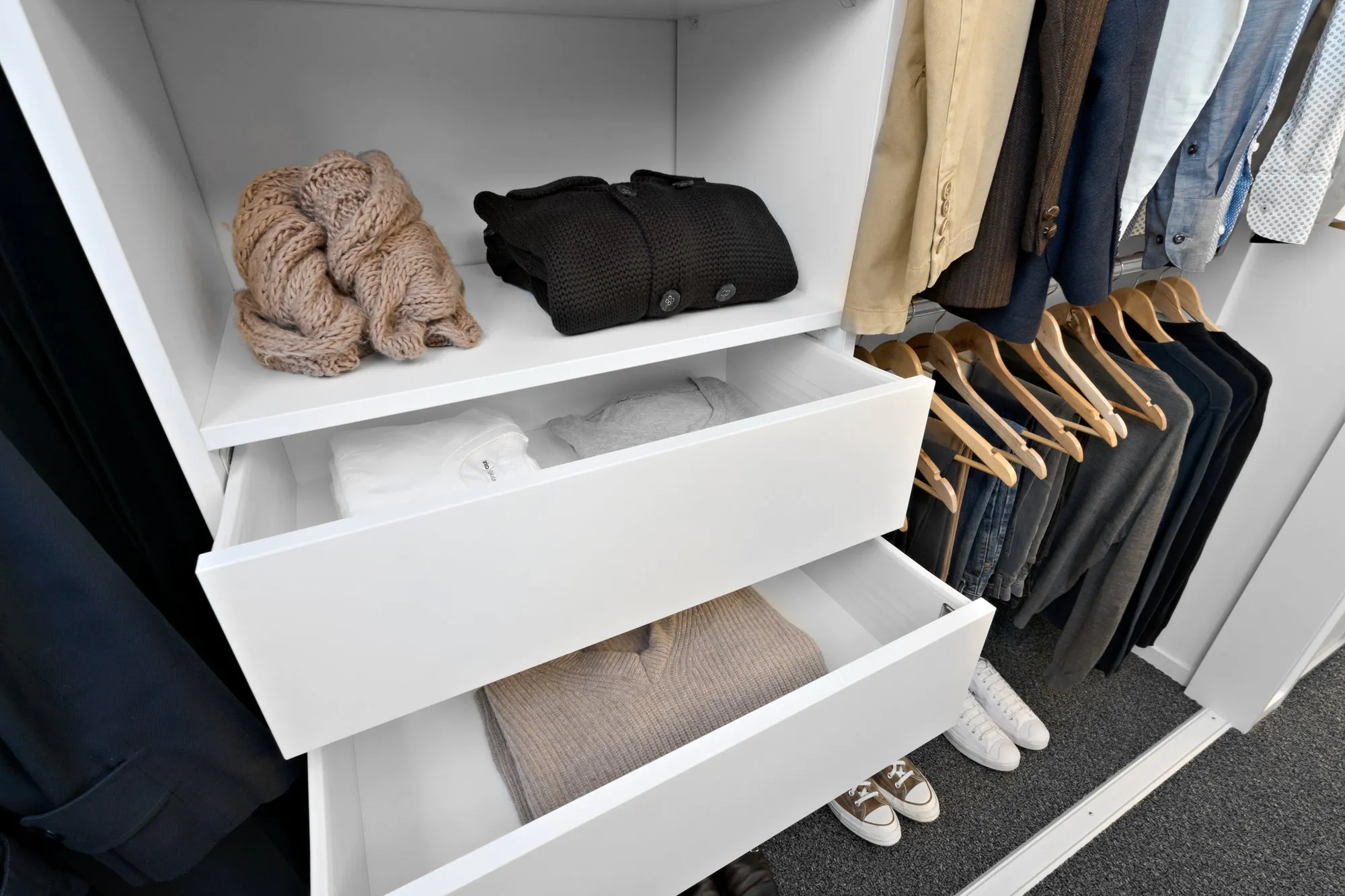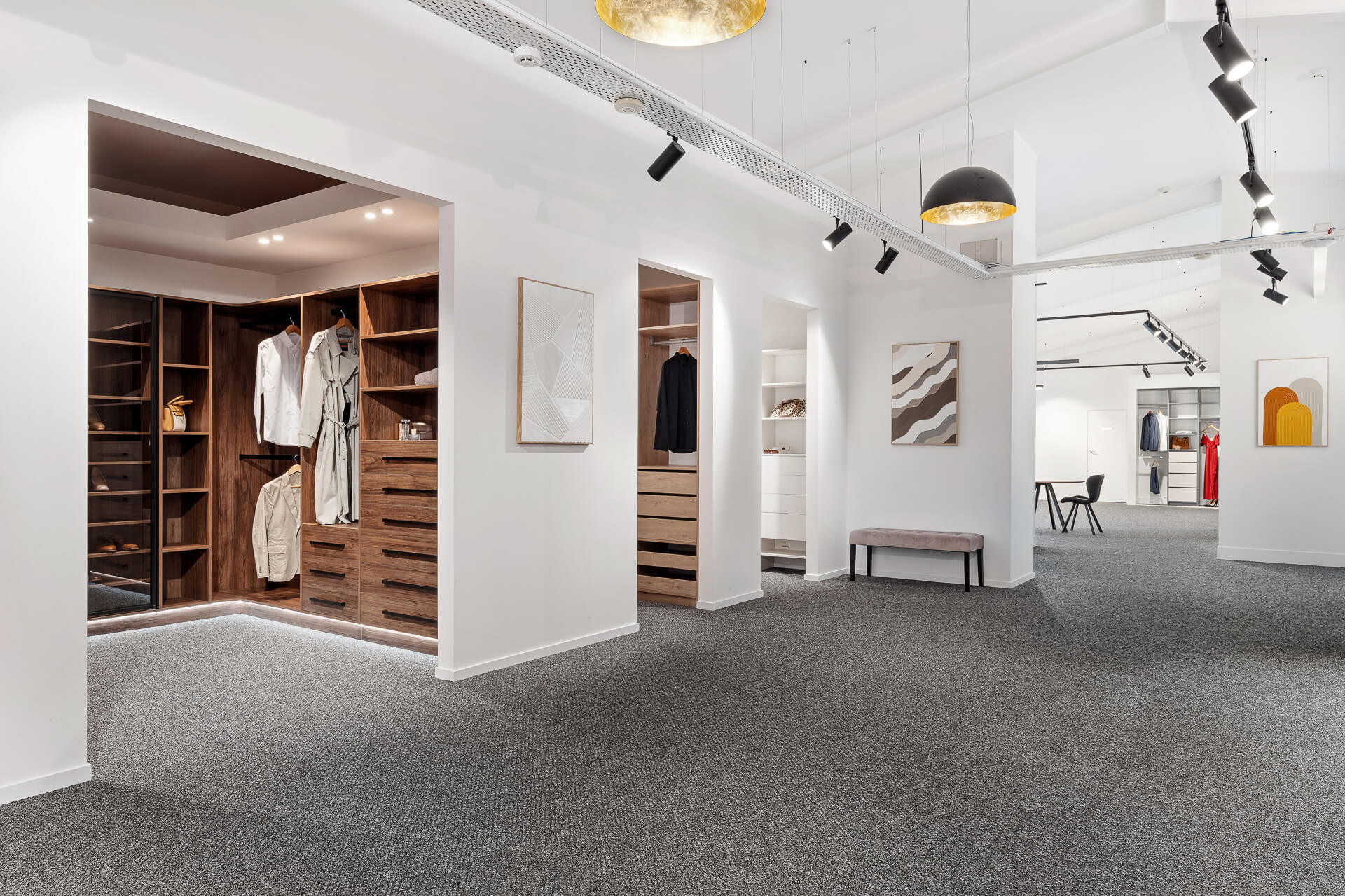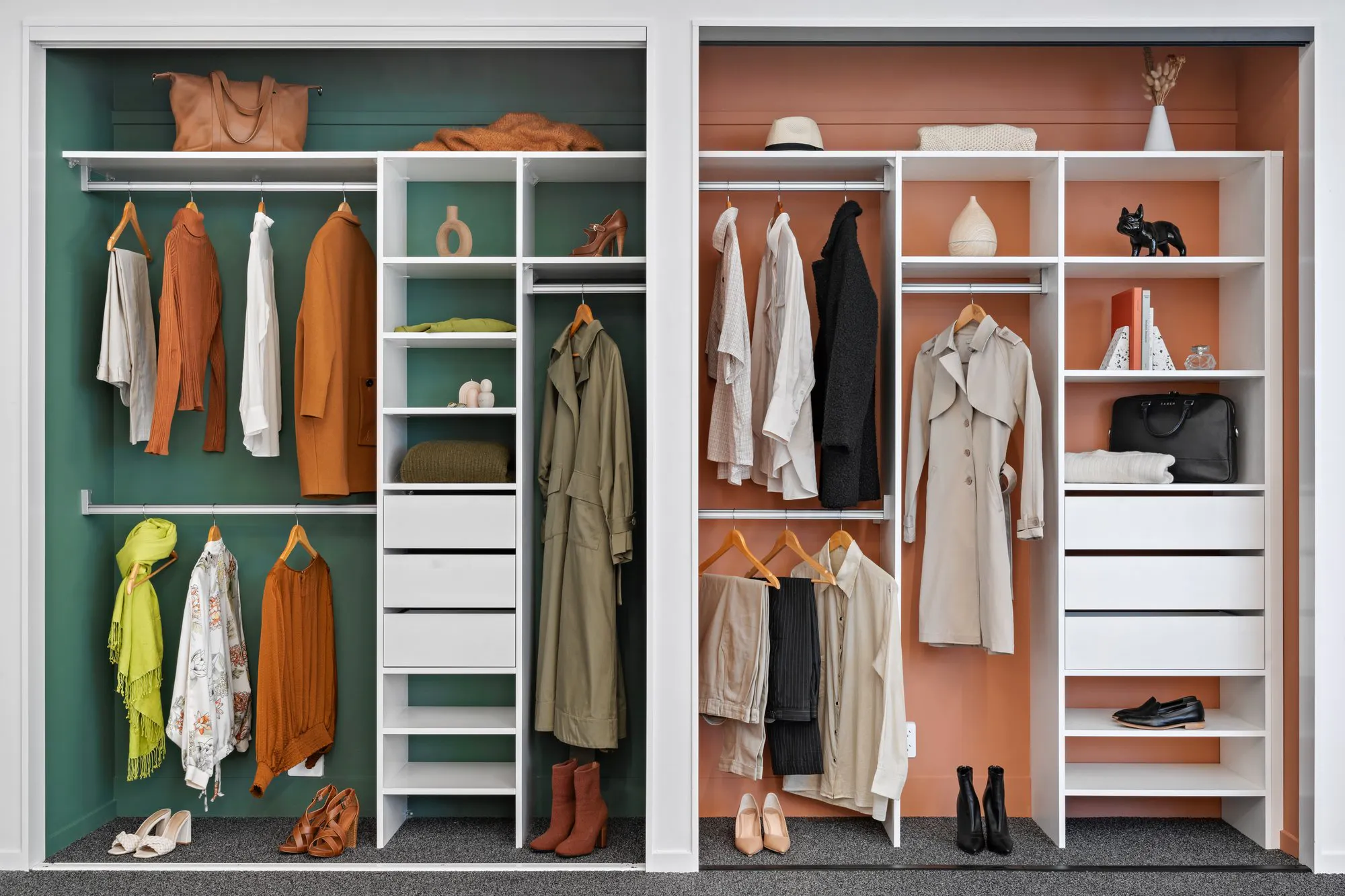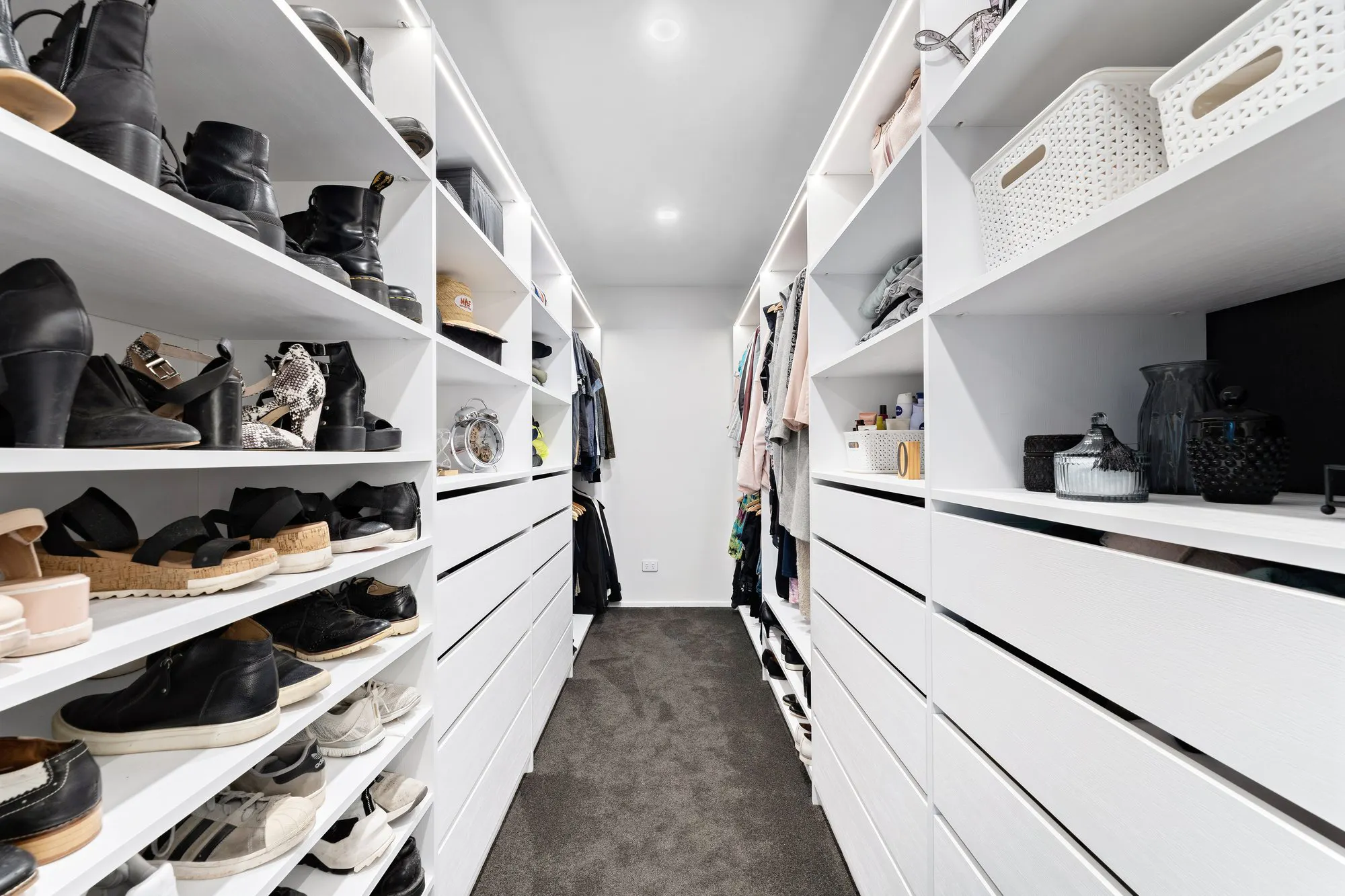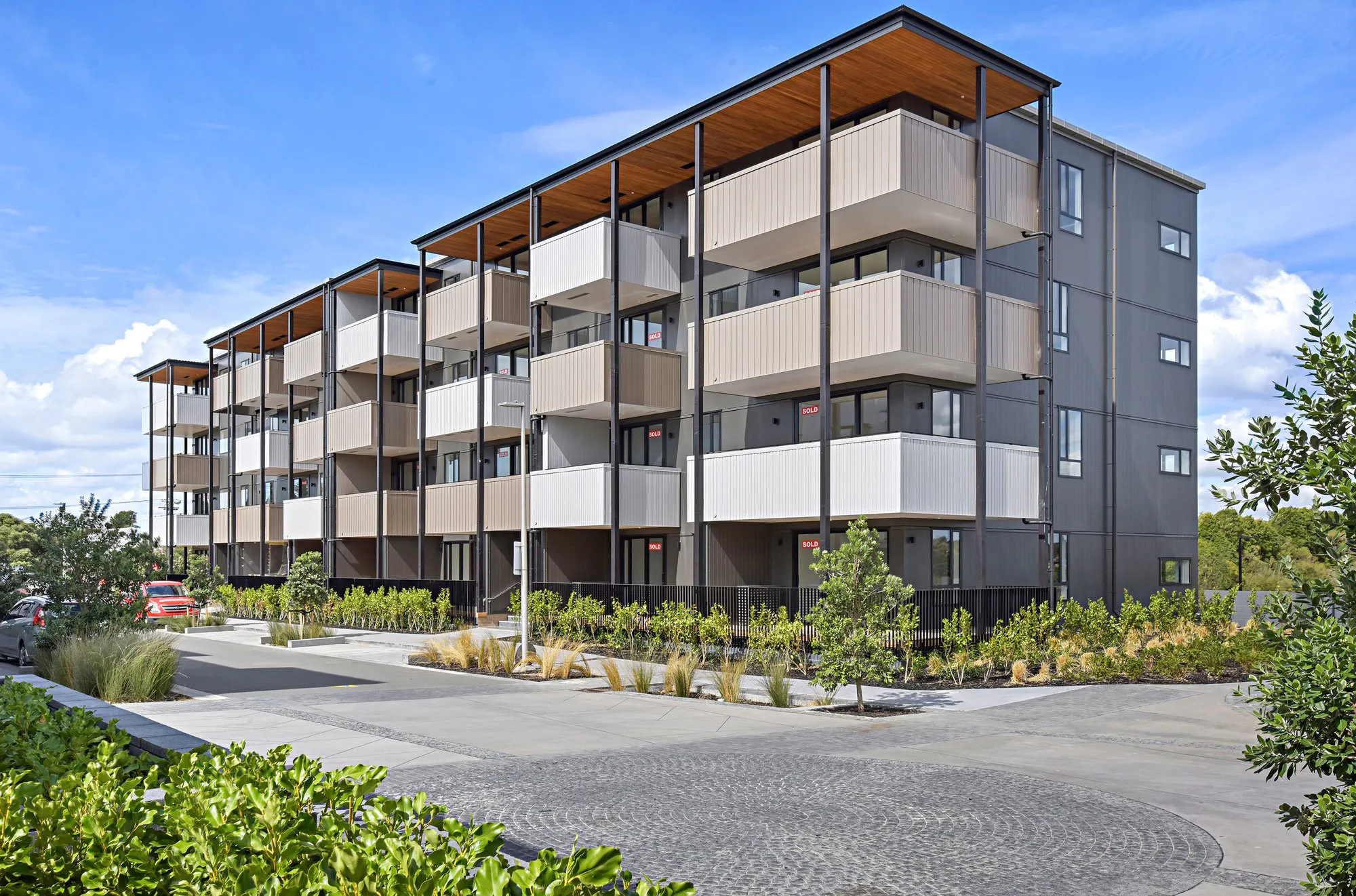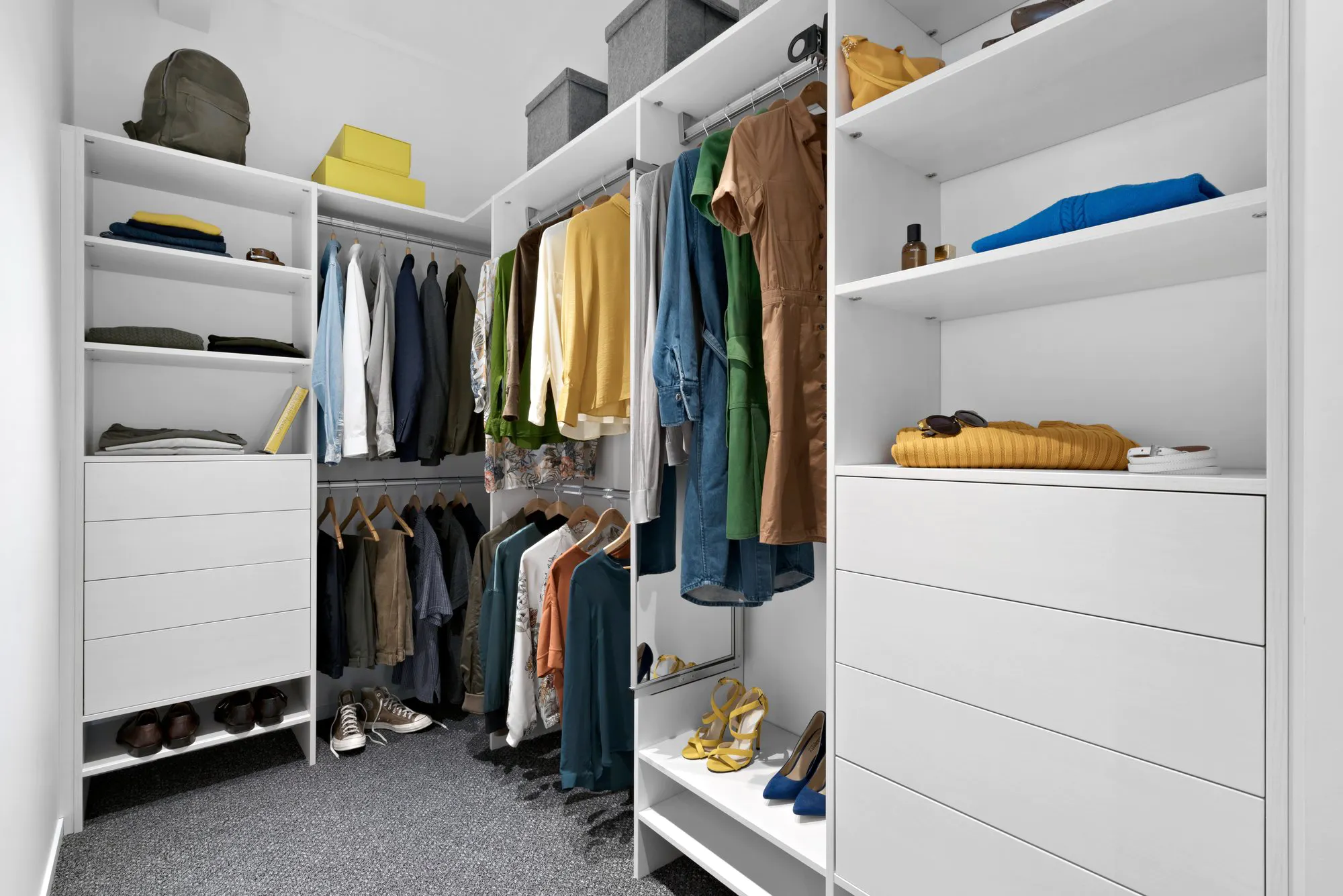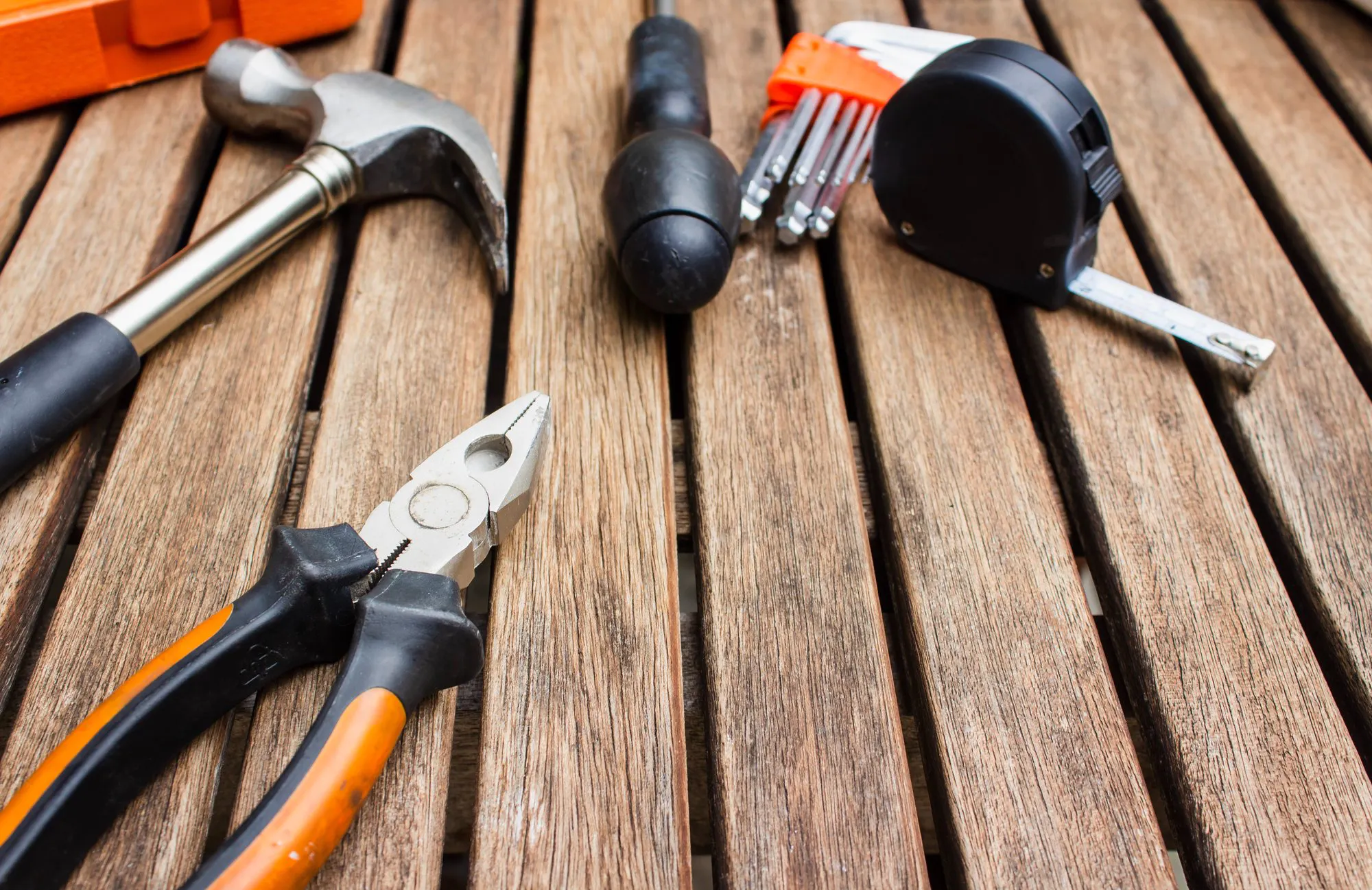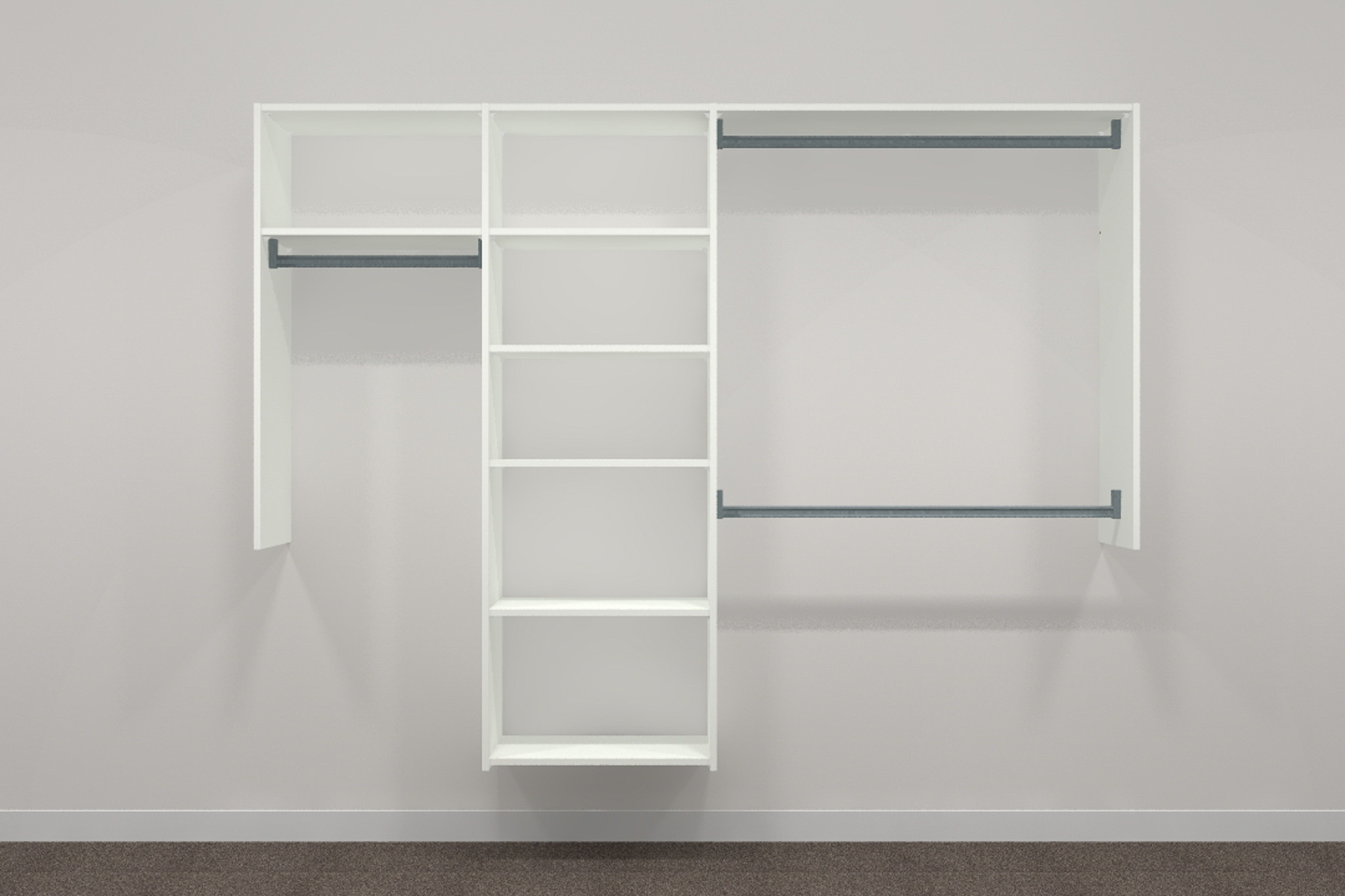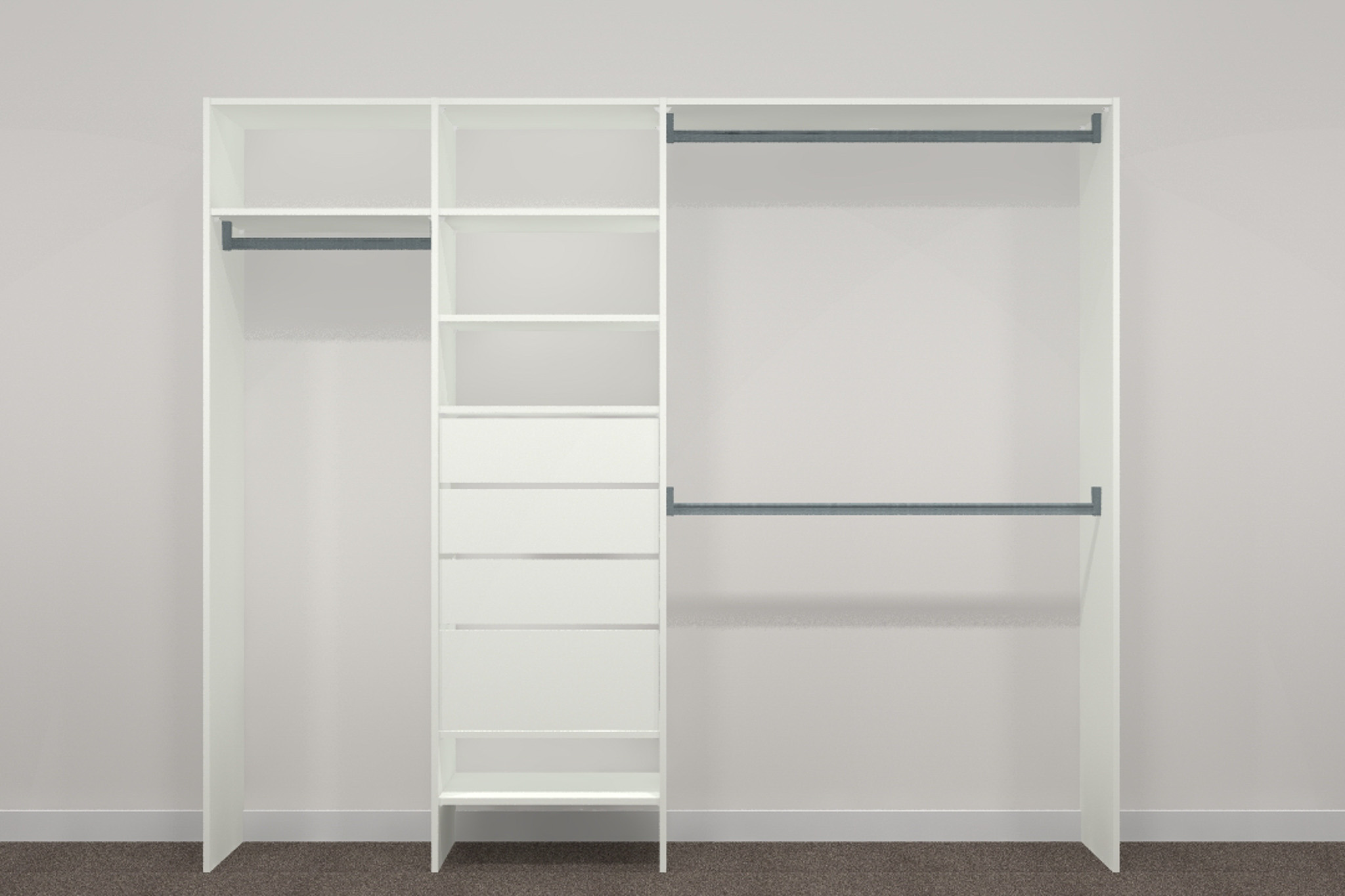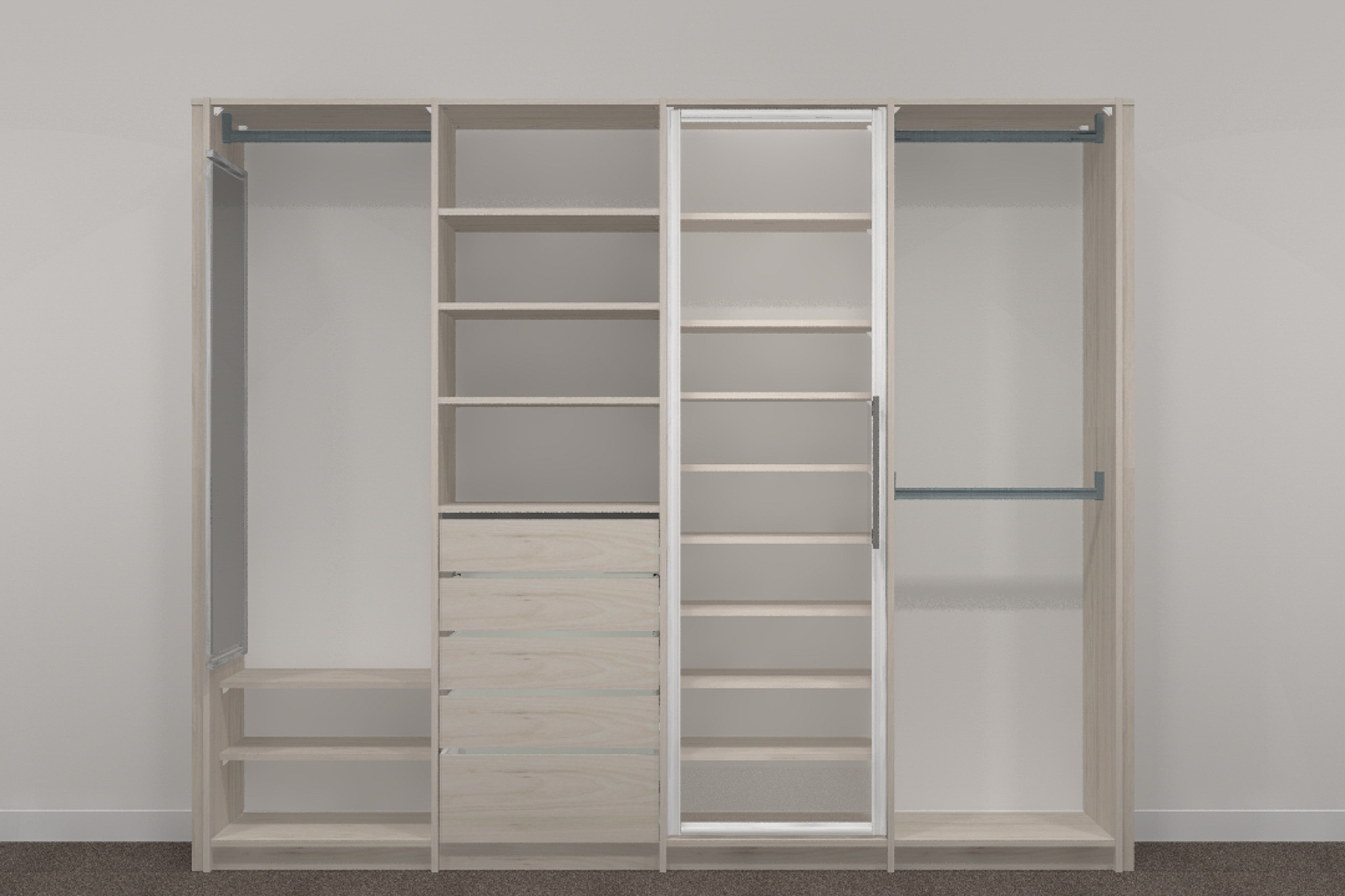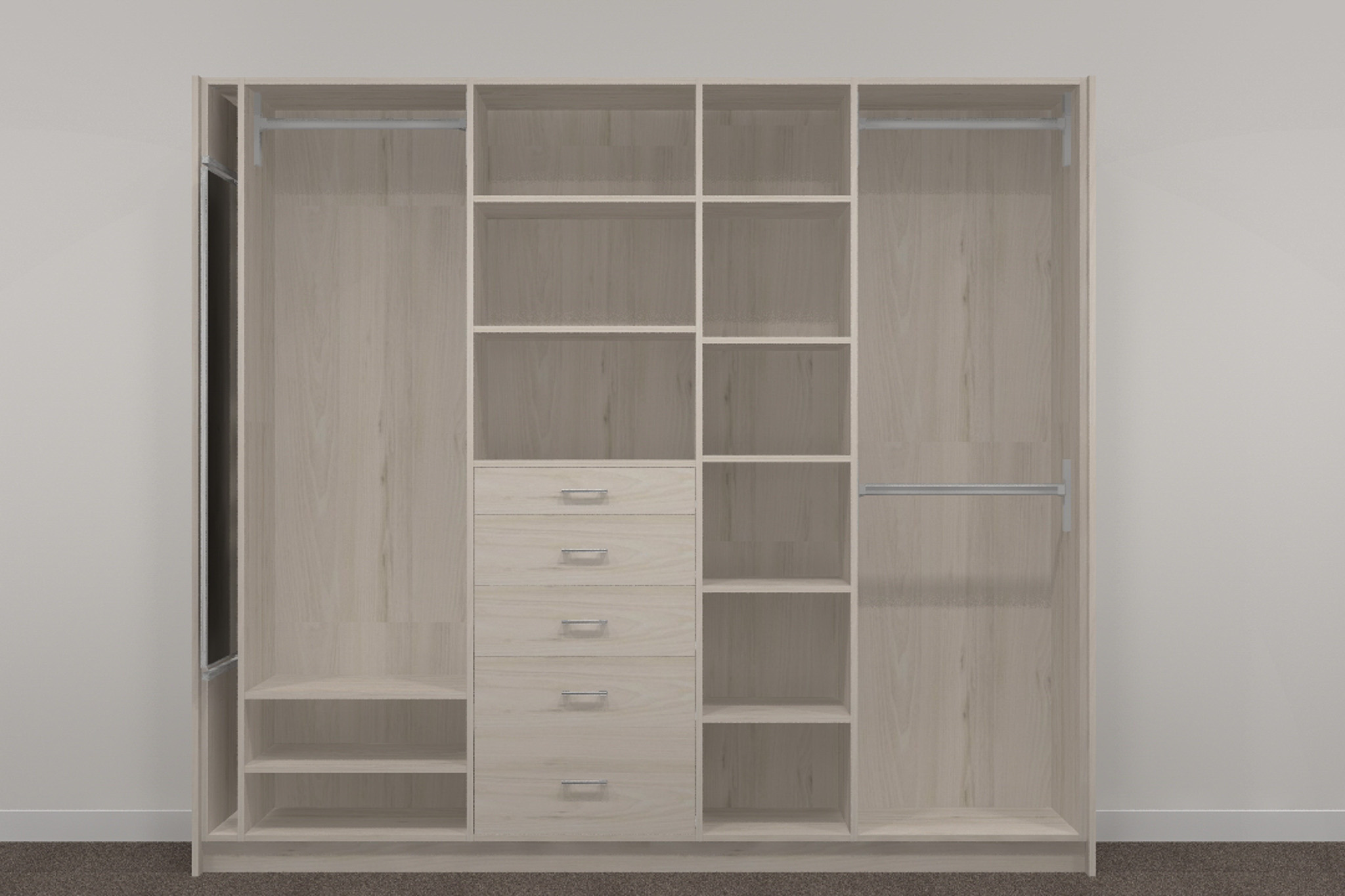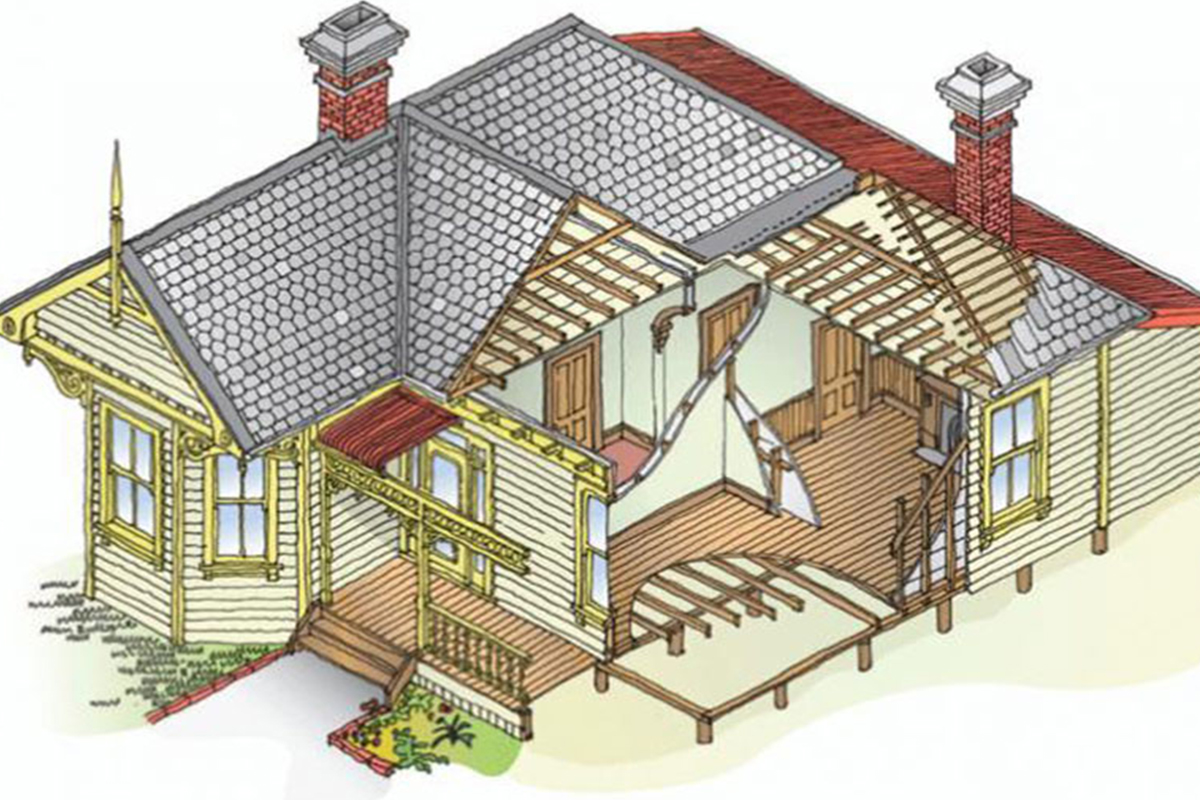What's happening in our wardrobe space: wardrobe design trends
What's happening in our Wardrobe space: Wardrobe Design Trends
Wardrobe design has evolved beyond mere functionality; it can be a reflection of personal style and a statement of individuality. Blending style and functionality, the humble wardrobe has the power to transform your bedroom and make your mornings easier. Let’s dive into the top trends that we are seeing shaping the landscape of wardrobe design in Auckland.
High-end Retail Wardrobe Design
Borrowing from high-end retail spaces, boutique-inspired wardrobe design exudes luxury and sophistication. Think glass shelving, stone benchtops, striking LED placement, and elegant accents. These designs create gorgeous displays, allowing your clothing and accessories to become the stars. Retail-inspired wardrobes transform everyday storage into a curated collection.
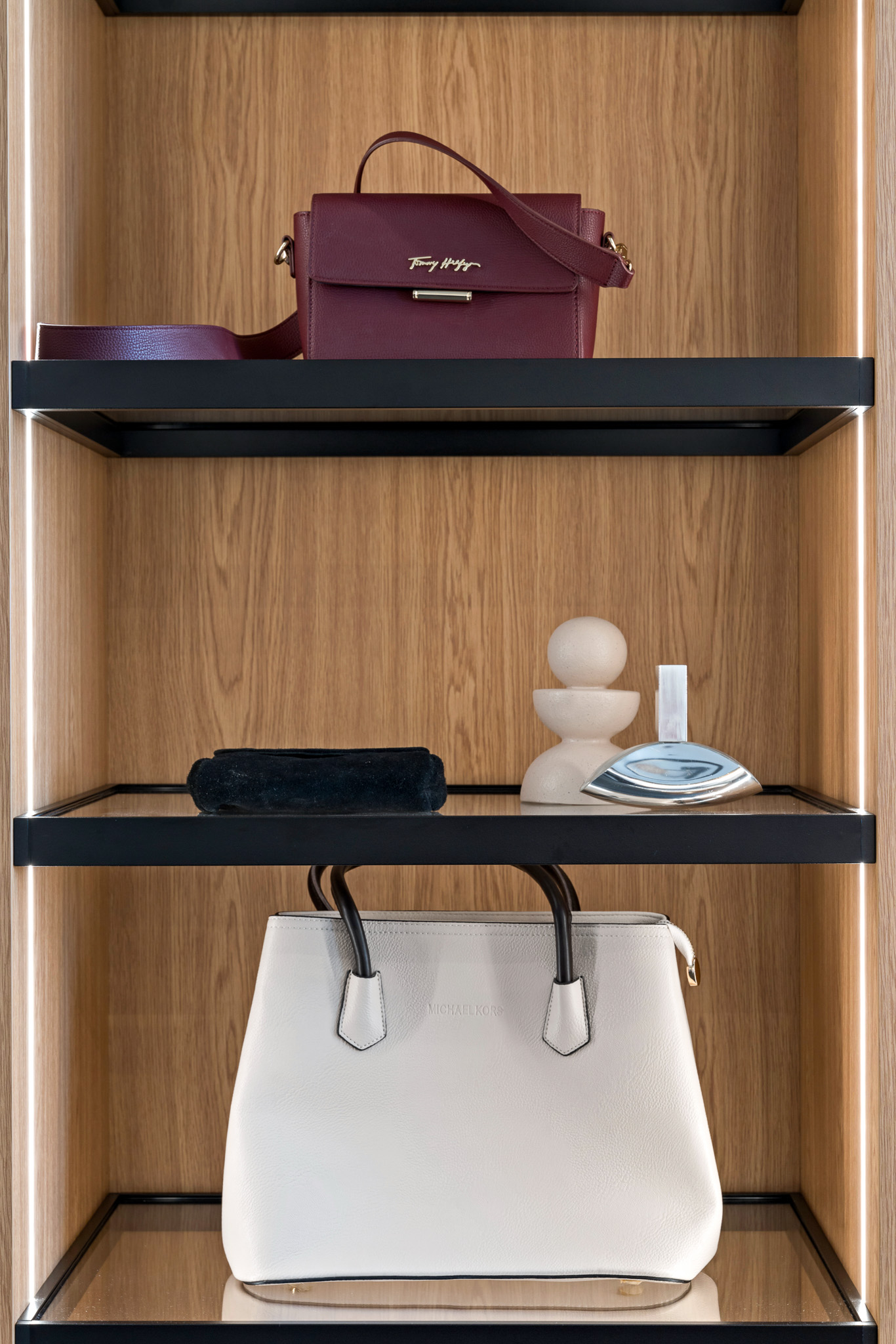
Freestanding Wardrobes
Viva, Boston Wardrobe’s freestanding wardrobe range, is having a moment in the spotlight. For homes that lack in-built wardrobe space, Viva offers a customisable wardrobe solution without the need for building work. Homeowners can achieve tailored storage and complex configurations while maintaining a considered aesthetic in any room of the house. This freestanding solution is fixed to the wall, ensuring a sturdy, durable and premium wardrobe. Match or accentuate your interior decor through panel colour, door panel detailing and handle choice.

LED Lighting
LED lighting is becoming a must-have for new wardrobes, offering energy-efficient illumination with endless design possibilities. Integrated LED strips create a soft, diffused glow, ensuring every item is visible and easily accessible. The direction of the LED strips is up to the individual, but we are loving the vertical placement of this beautiful Luxe walk-in at our showroom.
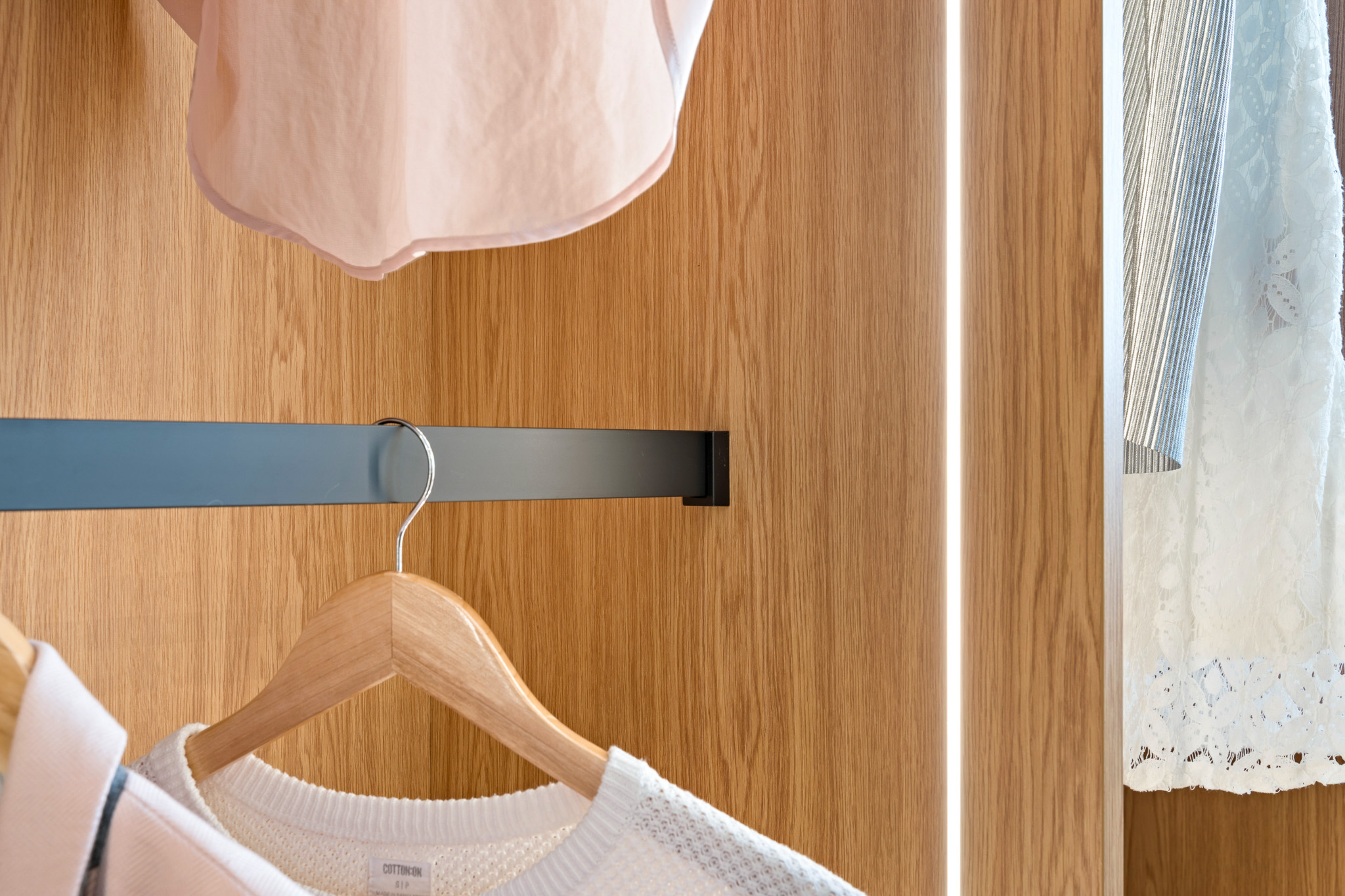
Colour Trends
Colour plays a significant role in defining the aesthetic of an interior space. Currently, woodgrains and dark colours are dominating the wardrobe design space, evoking a sense of modern chic. There is also a common thread of continuing cabinetry colour and style throughout the whole house so that kitchen, bathroom and wardrobe spaces work together to create the overall mood. Additionally, designers are incorporating pops of colour through accents and hardware, creating visual interest without overwhelming the space. You can view our colour options here, here and here.
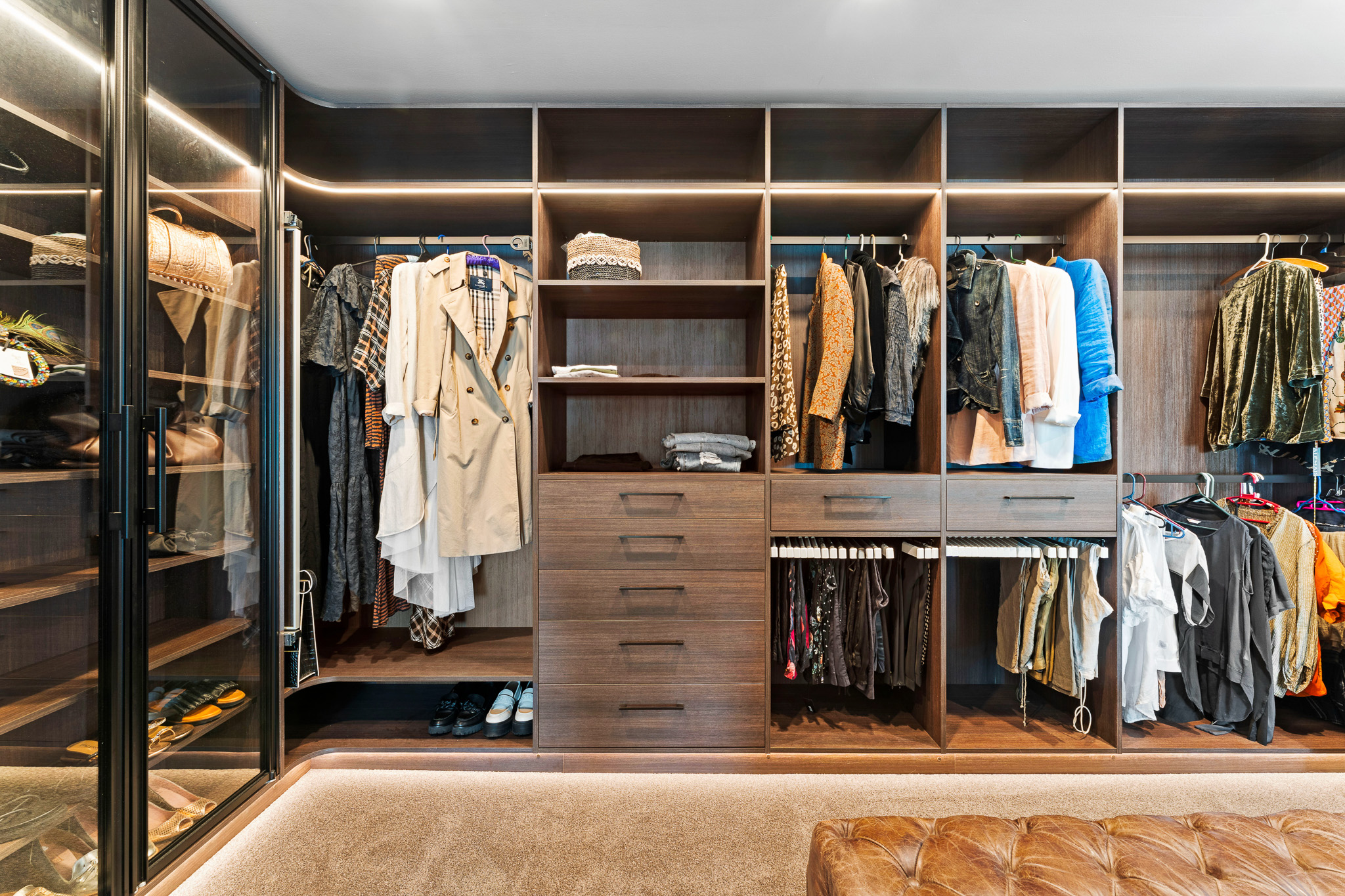
Handles
Handle choice is a small yet impactful component of wardrobe design, capable of enhancing or completely transforming the overall aesthetic. Pairing woodgrains with complementary metallic finishes is the cornerstone of this part of the wardrobe design process, but we are seeing an increase in bold choices resulting in sharp contrast and playful combinations. Choosing a handle option that goes against the expected silhouette can also modernise a traditional design. At Boston Wardrobes, we collaborate with any handle supplier to put the finishing touches on your wardrobe design.
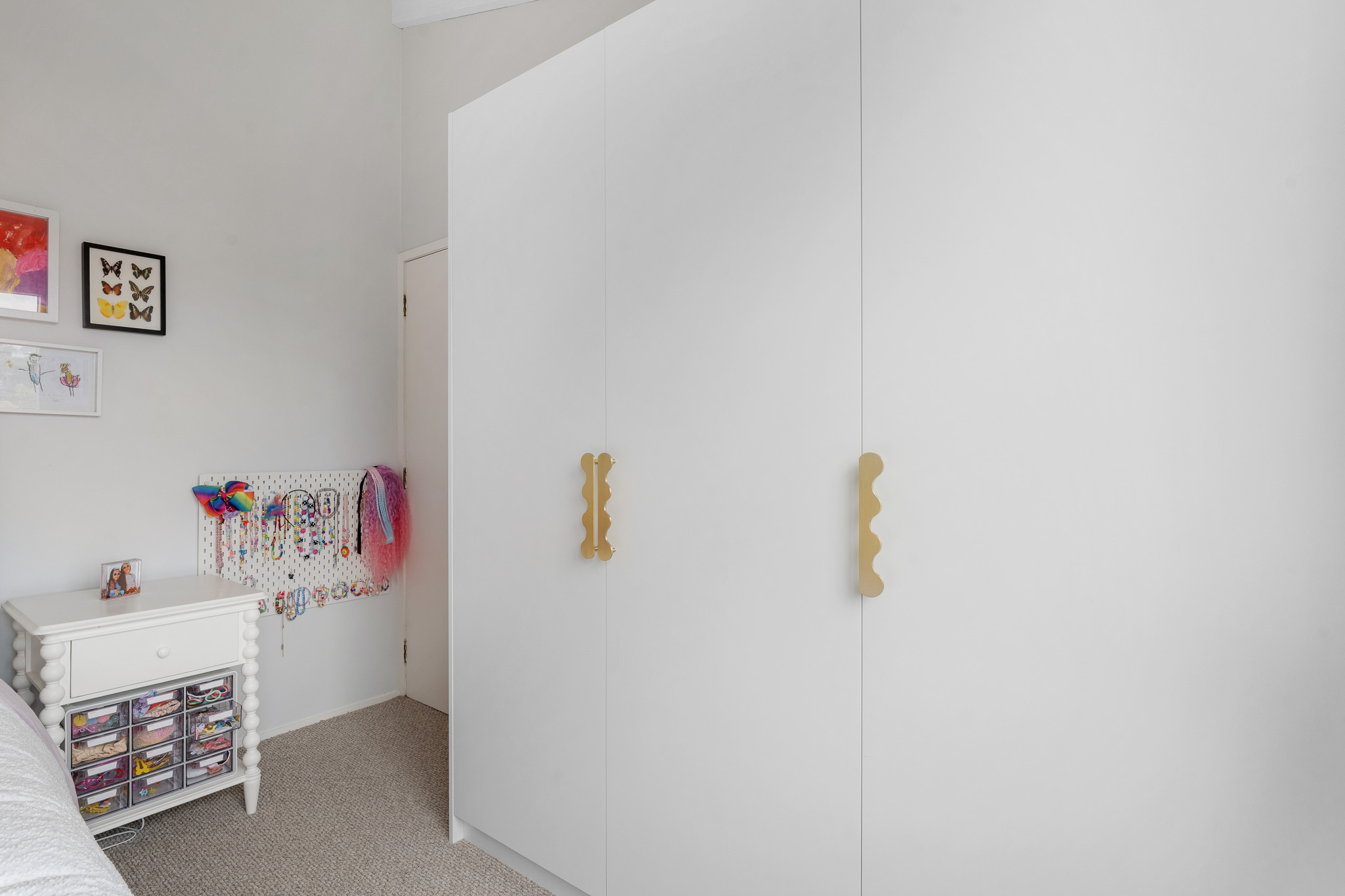
Shoe Storage
Shoe storage is often a challenge in wardrobe design, due to the volume of shoes typically owned and the lack of available space. However, it is one of the components of wardrobe design which can make the biggest improvement in the owner’s daily wardrobe interactions.
We love a vertical shoe tower where space allows for it, giving you instant visibility and showcasing shoe collections as a focal point within the wardrobe. The addition of glass pivot doors transforms the collection into a striking display. Another current favourite shoe storage solution is our pull-out shoe drawers, allowing you to tuck your shoes away for maximum tidiness and order, while still making them easily accessible when you need them.
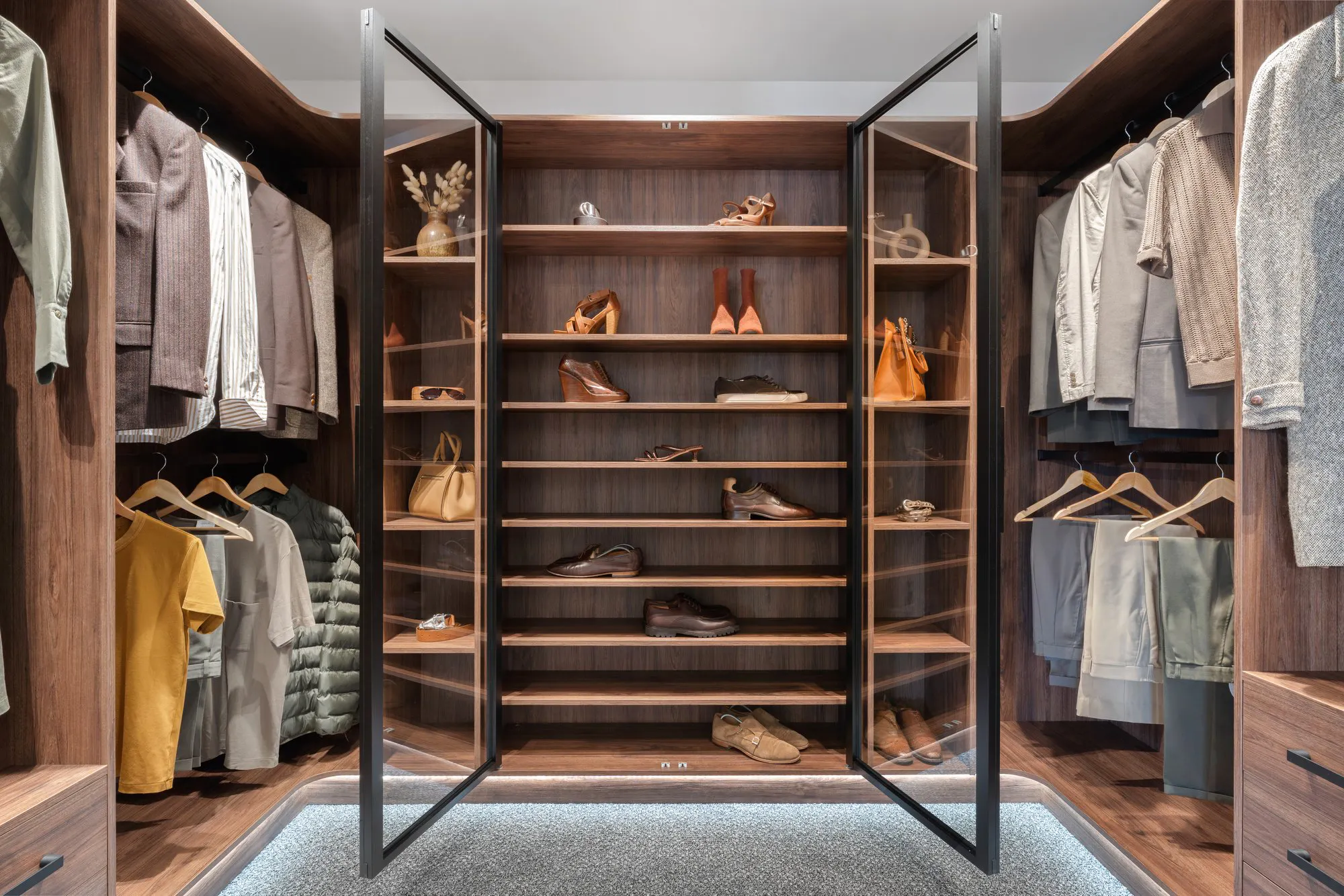
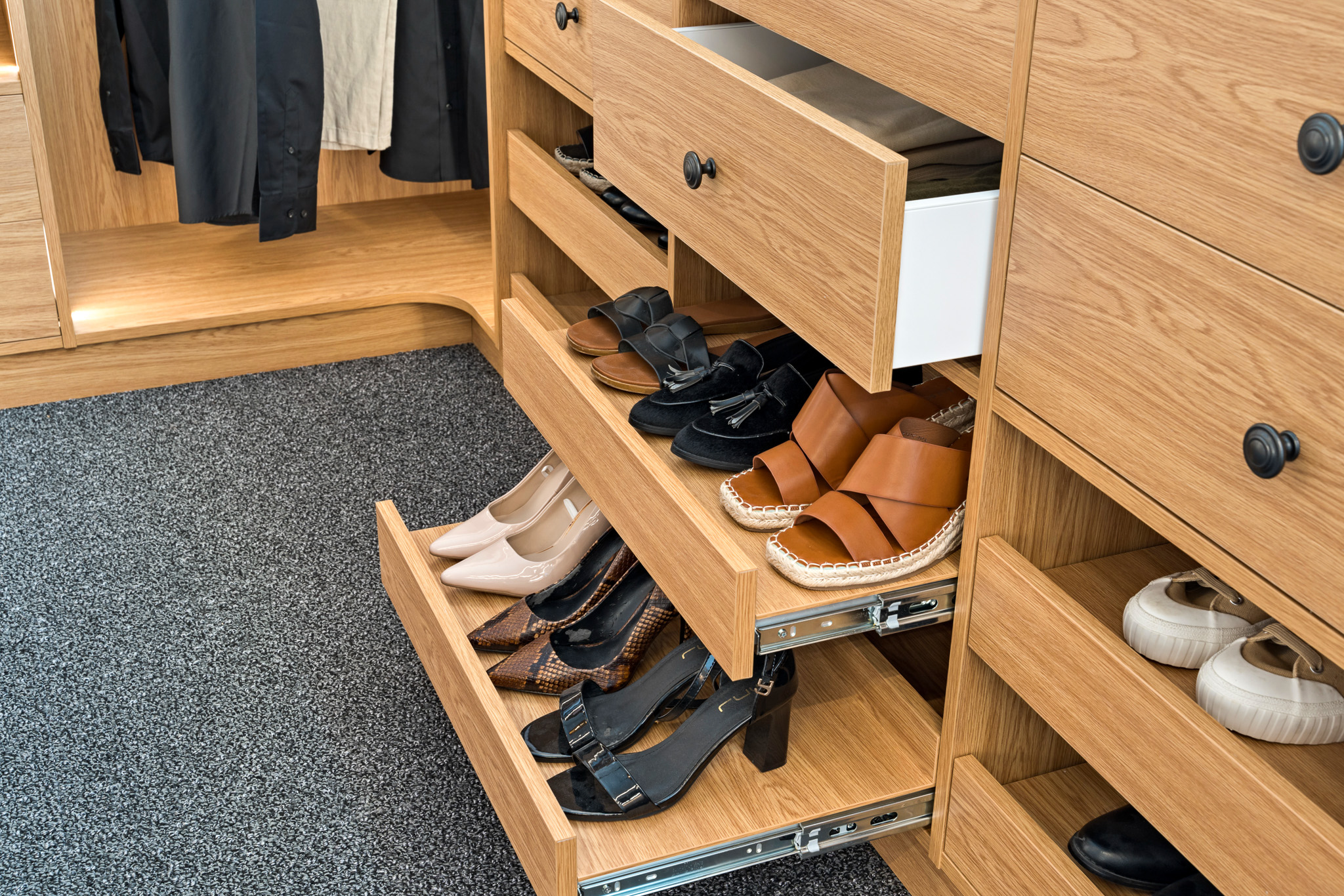
Drawer Tower Islands
These central islands can feature a combination of drawers and shelves, providing additional space for clothing and accessories. Drawer Tower Islands offer tailored storage solutions for everything from jewellery to folded garments such as underwear, activewear and knits. Incorporating materials like glass or stone countertops adds a touch of luxury to the wardrobe space, transforming it into a stylish dressing area. Drawer tower islands not only enhance organization but also level up the overall impact of the wardrobe.
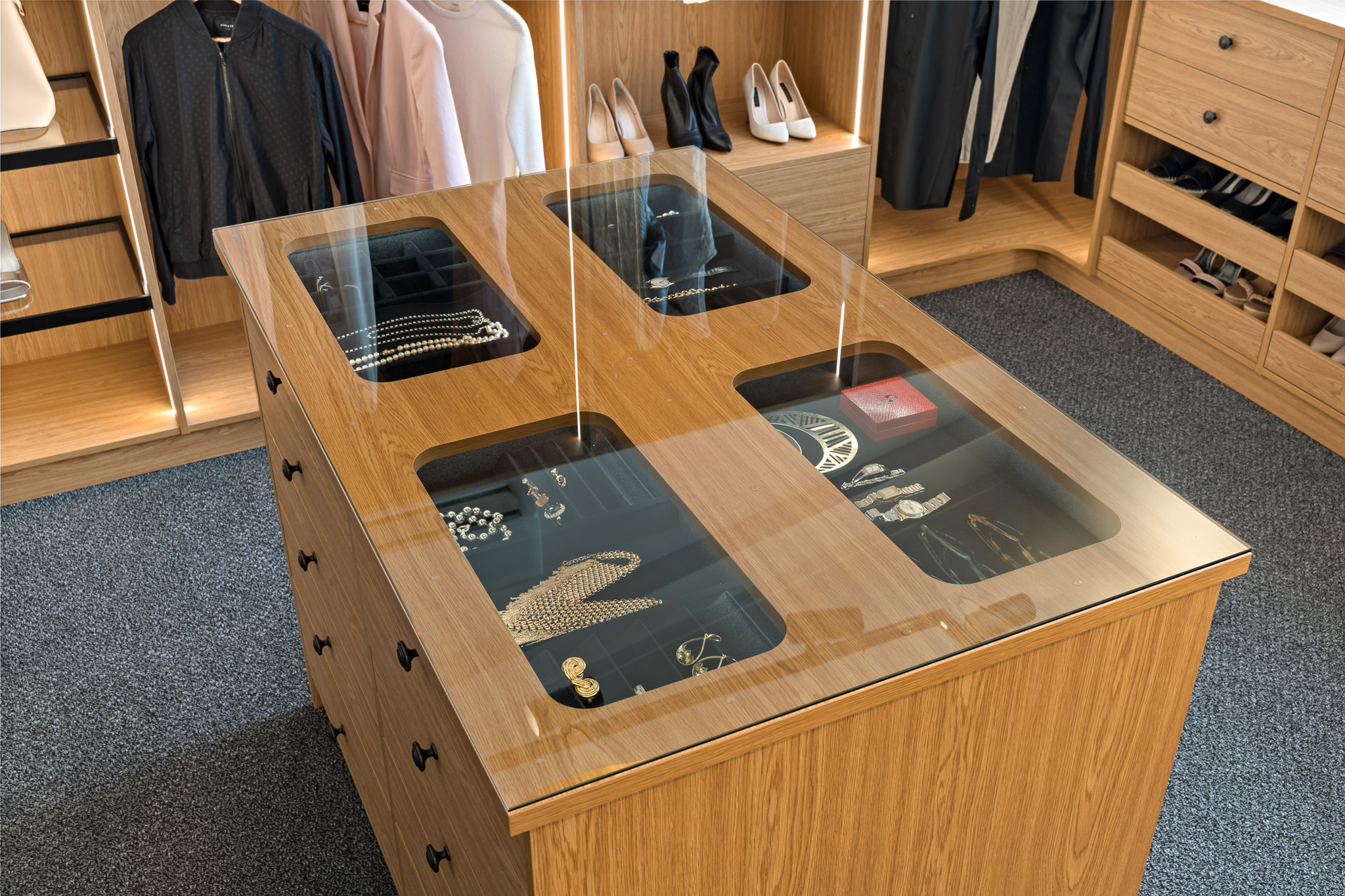
From boutique-inspired luxury to practical storage solutions, each of these wardrobe design trends reflects our understanding of current lifestyle and design preferences. Curious about what elements of wardrobe design you need to consider for your space? We would love to discuss your wardrobe project! Contact us today to book an appointment with one of our design consultants.
Other articles
May 8, 2024
What’s happening in our wardrobe space: wardrobe design trends
We're diving into the top wardrobe trends that we see shaping the landscape of wardrobe spaces in Auckland
April 7, 2024
The value of wardrobe storage in multi-unit residential interior design
A well-organised space is crucial to a sense of serenity at home, so creating the ideal storage solutions in multi-unit residential builds needs an expert hand.
March 8, 2021
How much will a new wardrobe cost?
Without a doubt our most frequently asked question, answered in great detail
The value of wardrobe storage in multi-unit residential interior design
The value of wardrobe storage in multi-unit residential interior design
The value of wardrobe storage in multi-unit residential interior design
A well-organised space is crucial to a sense of serenity at home, so creating the ideal storage solutions in multi-unit residential builds needs an expert hand. We spoke to Angela Amerigo of Boston Wardrobes to learn more about storage design in residential interiors.
Written by Natalie Clement at Archipro.
“We live in a consumerist culture, and most of us have a lot of stuff,” says Angela Amerigo of Boston Wardrobes.
Maximalist or minimalist, everything should have its place. A cluttered, poorly organised home is not only damaging to any aesthetic but is known to be detrimental to well-being. In the modern residence, efficient and well-planned storage solutions are essential and should be prioritised.
“A lot of us have lived in a house with inadequate storage and all the frustration that comes with that,” Angela shares. “Ask any realtor: potential buyers or tenants will be considering the storage space when evaluating a home. Properties with ample, well-designed storage will likely be more attractive and possibly even command a higher price. Storage is a key component of residential spaces, so it shouldn’t be overlooked or left to the last minute.”
The most common storage solution is the shelf-and-rail wardrobe, a low-cost option particularly common in older homes. Traditionally considered a simple, all-in-one option, the contemporary reality is much the opposite. This type of storage is rarely able to stand alone. Instead, it prompts the addition of more furniture and more purchases: chests of drawers, flimsy hanging shelves, and shoe racks, to name a few.
“This may work for a time, but a discerning homeowner wants their fixtures to be well thought out, of high quality, and of beautiful presentation, which is very hard to achieve with these makeshift solutions,” Angela explains.
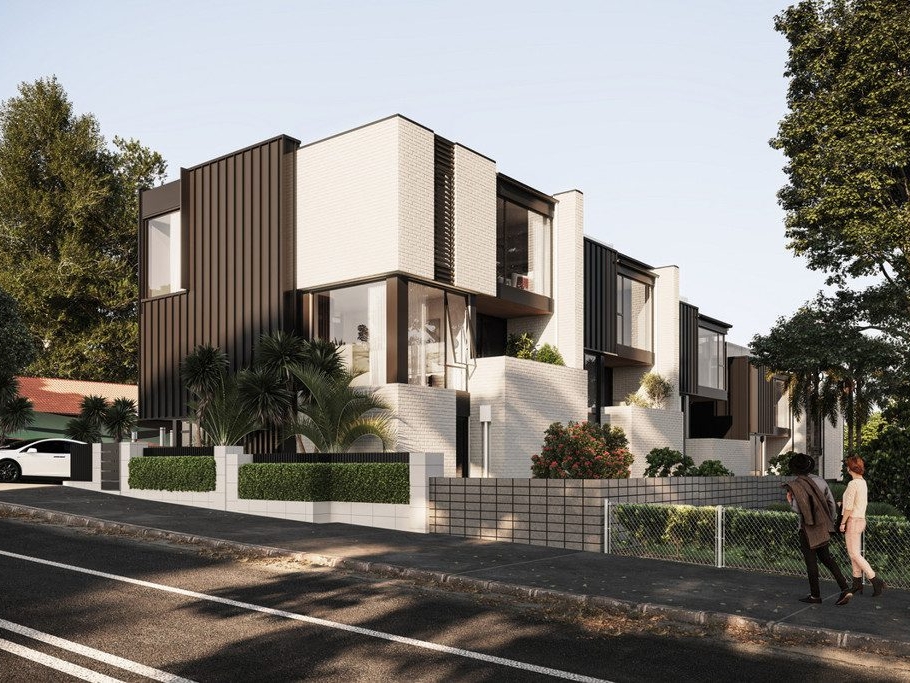
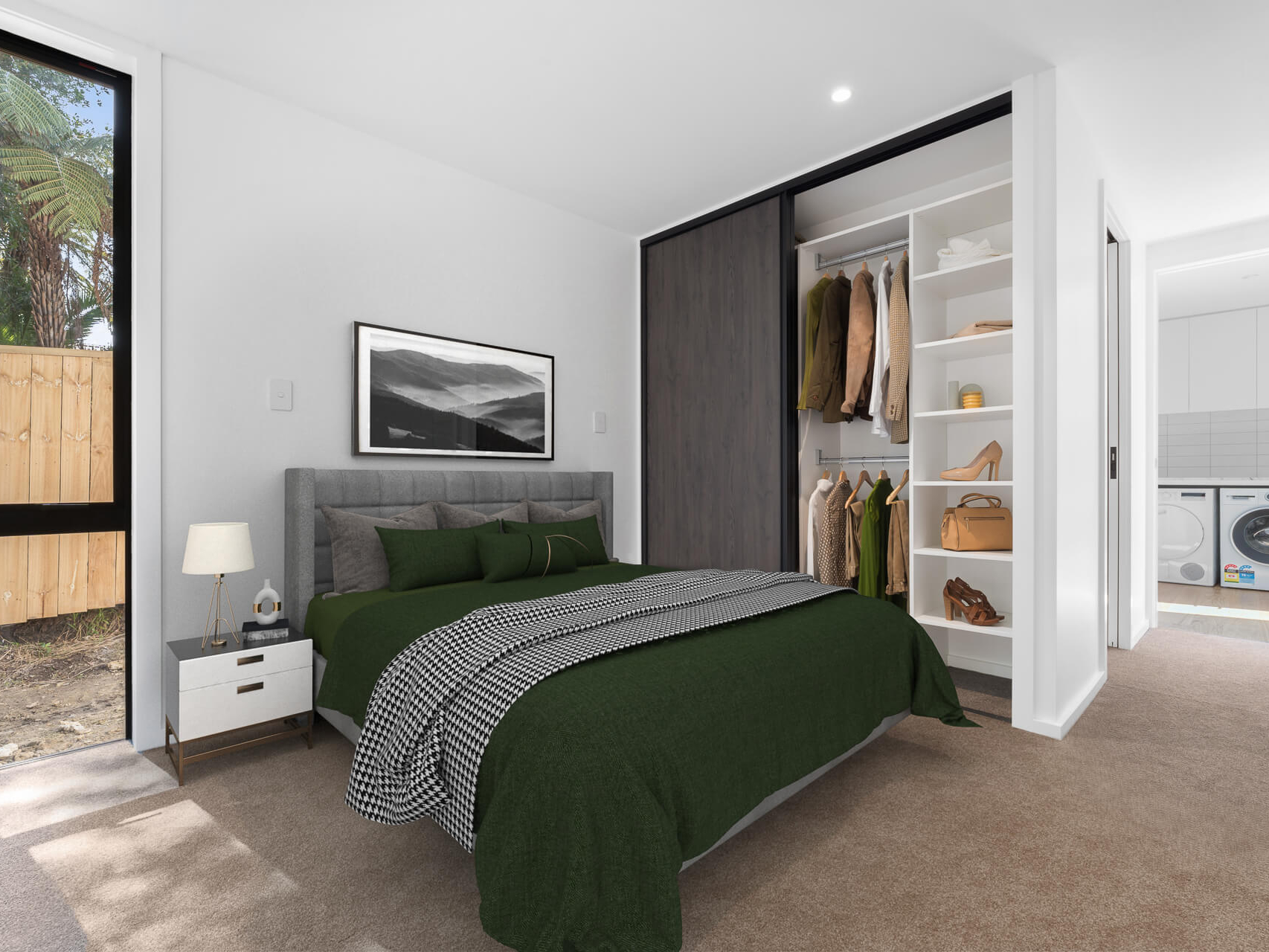
The key considerations for well-designed storage
Architects, property developers, and homeowners should consider several factors when integrating storage solutions into their residential projects, including timing, the intention of use for each space, and the home’s specifications.
Most importantly, start planning storage early in the design process. “Sometimes moving a door or wall slightly left or right can be the difference between a good wardrobe and an exceptional solution,” Angela shares. “Similarly, changing the size of the space slightly or the opening of the wardrobe area can transform the space, so easy to do at the right time, but almost impossible to do once building is underway.”
The storage built within each room should be considered based on the space’s planned function and usage. For instance, a laundry and utility area will require ample, smartly designed storage fit for smaller spaces.
Where possible, storage design should also consider the occupants’ lifestyles. For instance, floor-to-ceiling shelves for the avid reader, or large, tucked-away units for the growing family with young children.
For mid-to-high-end projects, a walk-in wardrobe is a necessity for the master bedroom, for instance, the Luxe wardrobe. While additional bedrooms don’t absolutely require this, each should feature more than just a shelf and a rail. The Select wardrobe offers a robust, cost-effective solution.
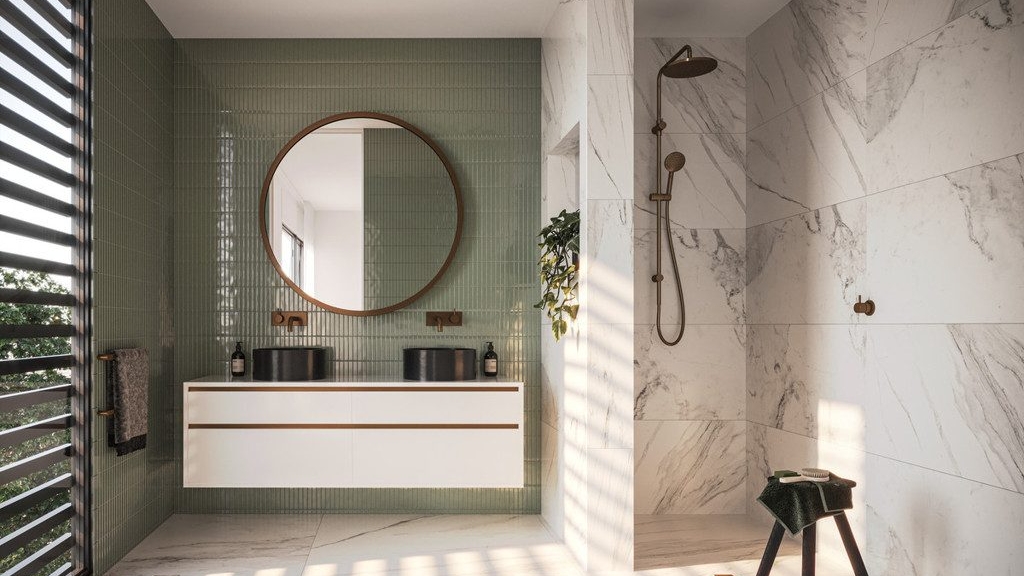
The challenges of storage design
With decades of experience in multi-dwelling developments, Boston Wardrobes has developed an intimate knowledge of the common challenges faced within residential storage design in large-scale projects and how to overcome them. These include limitations to space and budget, coupled with the need to maximise functionality and aesthetic appeal.
“The challenge is always: how do we get the most out of a limited space and within budget?” Angela explains. “All jobs have budgets, be it the value-end or the luxury-end. Our focus is to maximise the appeal and functionality.”
Simple but clever configurations include placing custom storage in underutilised spaces, such as under the stairs or awkward corners, or adding additional storage in spare rooms, while the addition of lighting in walk-in wardrobes creates an impactful, functional design.
“From some dimensions and a brief, we can create line and rendered views of any wardrobe spaces, linked to preliminary estimates, to be presented with confidence to clients or included in documentation and proposals,” Angela adds.

The impact of well-designed storage
The core purpose of storage is to provide a home for valued possessions. In the context of wardrobe design, Angela explains, “Collectively, clothes, shoes, and jewellery are some of our most valuable personal assets and usually comprise a large number of items.”
When there is a place for everything, and everything has its place, the impact is felt daily. Well-designed storage ensures a calming spatial experience and ultimately protects some of the most valuable objects the occupant owns.
The design style of the project should inform the integration of storage. An industrial, minimalist interior design may favour the Innova wardrobe with its sleek metal stanchions, a Victorian character home will likely favour the panelled Villa wardrobe doors, or perhaps a luxury residential design will seek a Boston Wardrobes bespoke solution.
“Ensuring that the solution is beautiful, functional and ties in with the overall decor and other fixtures within the space will add immeasurable value to the project,” Angela adds.
Investing in high-quality storage solutions also ensures the durability of products that will likely be interacted with every day. This resilience is crucial to reducing the need for replacements and add-ons so often found within the ‘shelf-and-rail’ style, therefore mitigating the need for the use of extra resources.
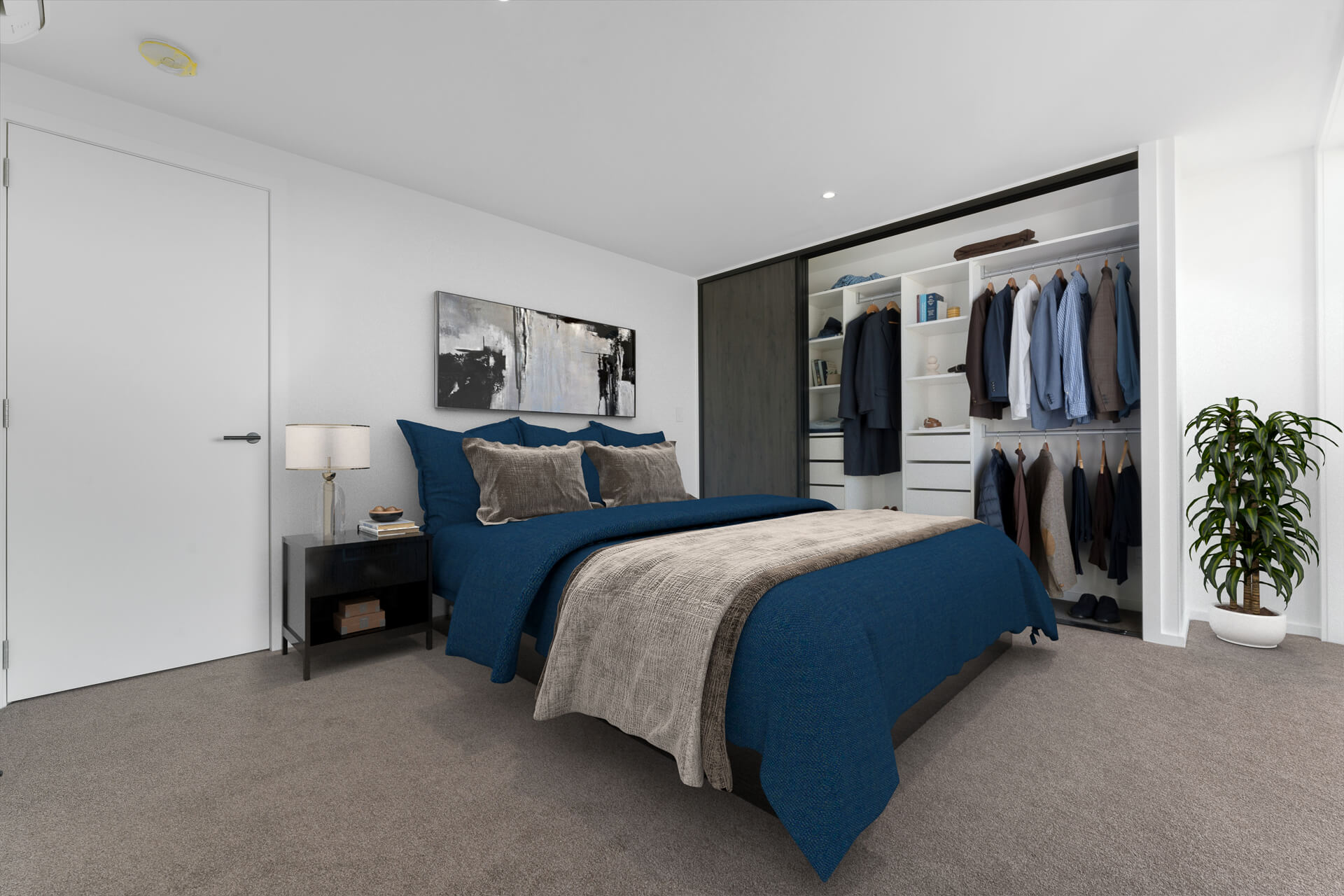
The future of storage in interior design
As an increasing number of people are putting ample, appropriate storage higher up their list of priorities in the property search, looking ahead, Boston Wardrobes anticipates that homeowners will seek to make storage, and particularly wardrobes, a feature of their rooms rather than hiding them in the background.
The latest emerging trends are indicative of this hypothesis, incorporating more colour, materials, and lighting to curate a storage solution that reflects the homeowner’s style and personality.
Storage is a critical component of residential spaces that should be prioritised. A well-designed storage solution enhances both functionality and aesthetics, contributing to the overall satisfaction and value of a residential project. With this in mind, Angela’s advice is clear: engage a specialist in the early planning stages to ensure the storage solutions are properly integrated into the project.
Other articles
May 8, 2024
What’s happening in our wardrobe space: wardrobe design trends
We're diving into the top wardrobe trends that we see shaping the landscape of wardrobe spaces in Auckland
April 7, 2024
The value of wardrobe storage in multi-unit residential interior design
A well-organised space is crucial to a sense of serenity at home, so creating the ideal storage solutions in multi-unit residential builds needs an expert hand.
March 8, 2021
How much will a new wardrobe cost?
Without a doubt our most frequently asked question, answered in great detail
The stress-free solution to wardrobe storage
The stress-free solution to wardrobe storage
As a feature of the home that we interact with every day, the importance of wardrobe storage should not be underestimated. We spoke to Natalie Clement at Archipro to reveal the secrets to stress-free wardrobe storage.
The relationship between organisation and mood has been thoroughly researched over the years. One study, published in the Journal of Environmental Psychology in 2016, found those whose homes are cluttered and disorganised experienced higher levels of stress compared to those who had well organised and tidy living spaces.
Since 1987, Boston Wardrobes has been guided by a belief in ‘better living through organisation’. “We know what a positive change a good storage solution can make to your home,” shares Angela Amerigo.
“It may sound silly, but a well-designed wardrobe can make your life better. Things are easier to find, your clothes are better cared for, mornings are easier. We make it easier for people to keep their homes tidy by having fit-for-purpose storage, custom designed to their needs, which in turn will hopefully make the rest of their home life better, more manageable, and less stressful.”
Fundamentally, thoughtfully designed wardrobe storage can enhance your everyday living experience. While quality wardrobe storage is evidently beneficial, it can be challenging to get right without expert guidance.
“Just like you would want an experienced designer handling a new kitchen or bathroom project, equally you will get best results when you have a wardrobe designer deal with wardrobe spaces,” shares Angela.
“The biggest issue we see people facing when it comes to wardrobes is space and access,” adds Angela. “People with existing wardrobes with hinged doors, the old poky sort, with a whole lot of inaccessible space in the side returns and on top want a lot to fit into what is often not that big a space. Shoes are also a big one — everyone wants a better way to store their shoes.”
Boston Wardrobes’ four-step process offers a stress-free solution to solve these problems. The comprehensive remedy starts with a visit to their showroom followed by a design and quote. With this agreed, the third step is a home visit, after which professional installation is taken care of.
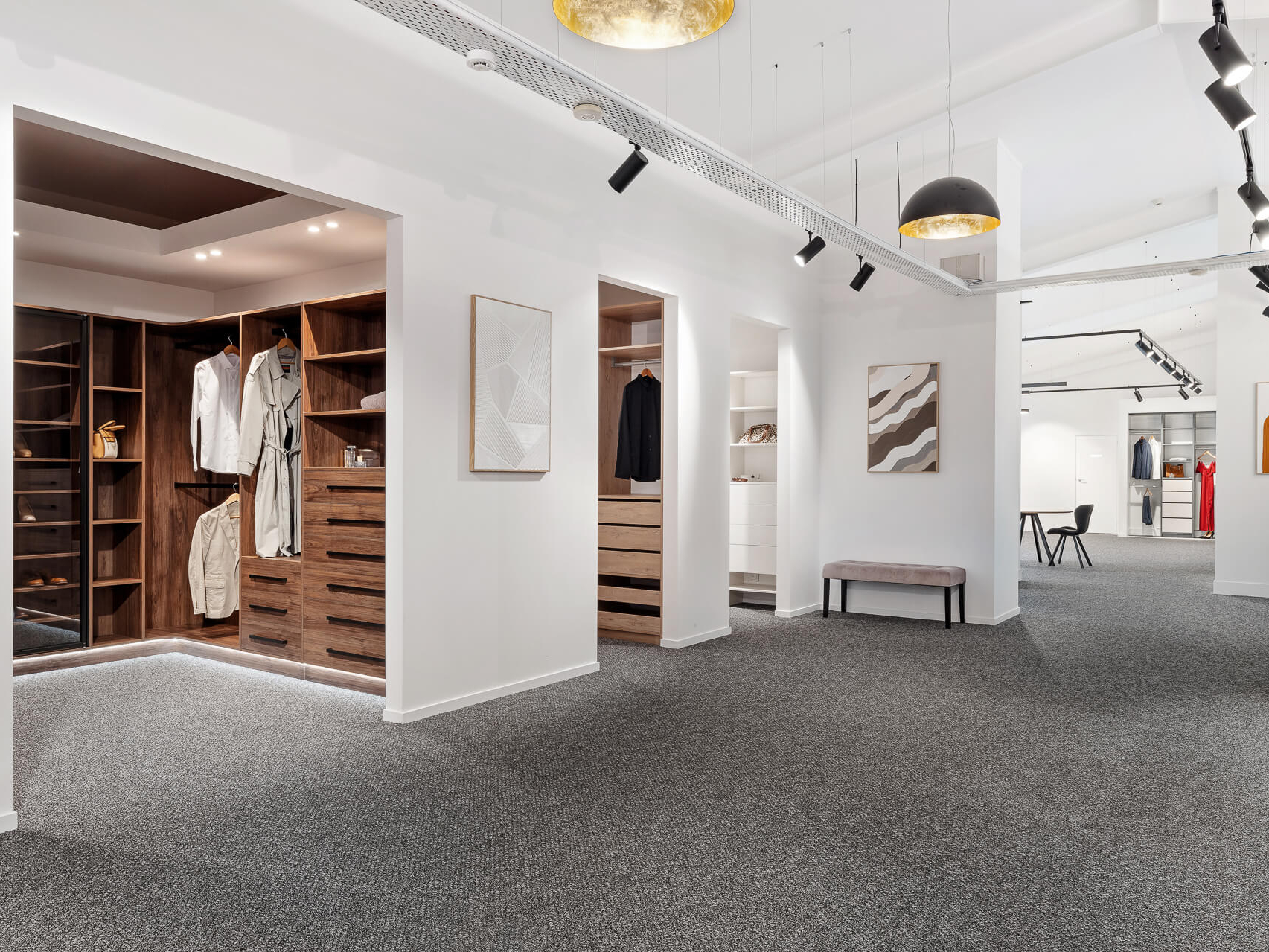
Step 1: Visit the showroom
Located at 57 Boston Road in Auckland, Boston Wardrobes’ vast 250 sqm showroom, the largest in Auckland, allows you to visualise your new storage solution. “I think people are surprised at what can be done. Often when people visualise a wardrobe, they think of some boring white shelves and rails. But that’s not what you see when you come into the showroom,” explains Angela.
“We’ve designed the displays to inspire your imagination and get you thinking about your own perfect wardrobe. We want you to love your wardrobe every time you use it. It should be designed for your specific needs, taking into account your sneaker obsession, your designer jeans collection, or your abundance of accessories.”
The showroom has continuously evolved over Boston Wardrobe’s 35 years in the industry to showcase the latest products and trends. Inside, you’ll find multiple life-sized walk-ins, reach-ins, and standalone wardrobes, as well as home storage solutions for laundry and living rooms. Every wardrobe and wardrobe range on offer is available to view in all its configurations, along with accessories, colour options, and a selection of handle hardware to finish your project.
“Seeing and feeling all of the different options gives you a much better idea of what to expect. You wouldn’t buy a new kitchen without first visiting a showroom! Wardrobes might be smaller, but they can be just as complex, and just as life-saving,” Angela explains. “Every single one of our customers comments on how valuable the showroom visit is to their overall experience.”

Step 2: Design and quote
At the showroom, you’ll view the extensive selection and discuss your requirements with a design consultant. “At this stage it is helpful to bring in any building plans if you have them or alternatively a hand drawn sketch of the space you are working on with measurements, maybe even a few photos, so we can get to work straight away.” Angela shares.
The thorough consultation ensures your needs are met within your budget, usually lasting around 30-45 minutes for a single wardrobe. The design consultant takes into account your storage needs, the available space, lighting, as well as matching colours and textures to the rest of the house, to sketch a bespoke wardrobe storage system tailored to your unique requirements.
“The consultant will be with you one-on-one right through the whole process, from consultation, to design, measurement on site, right up until the install date. So you will be talking to someone who knows the full picture every time.”
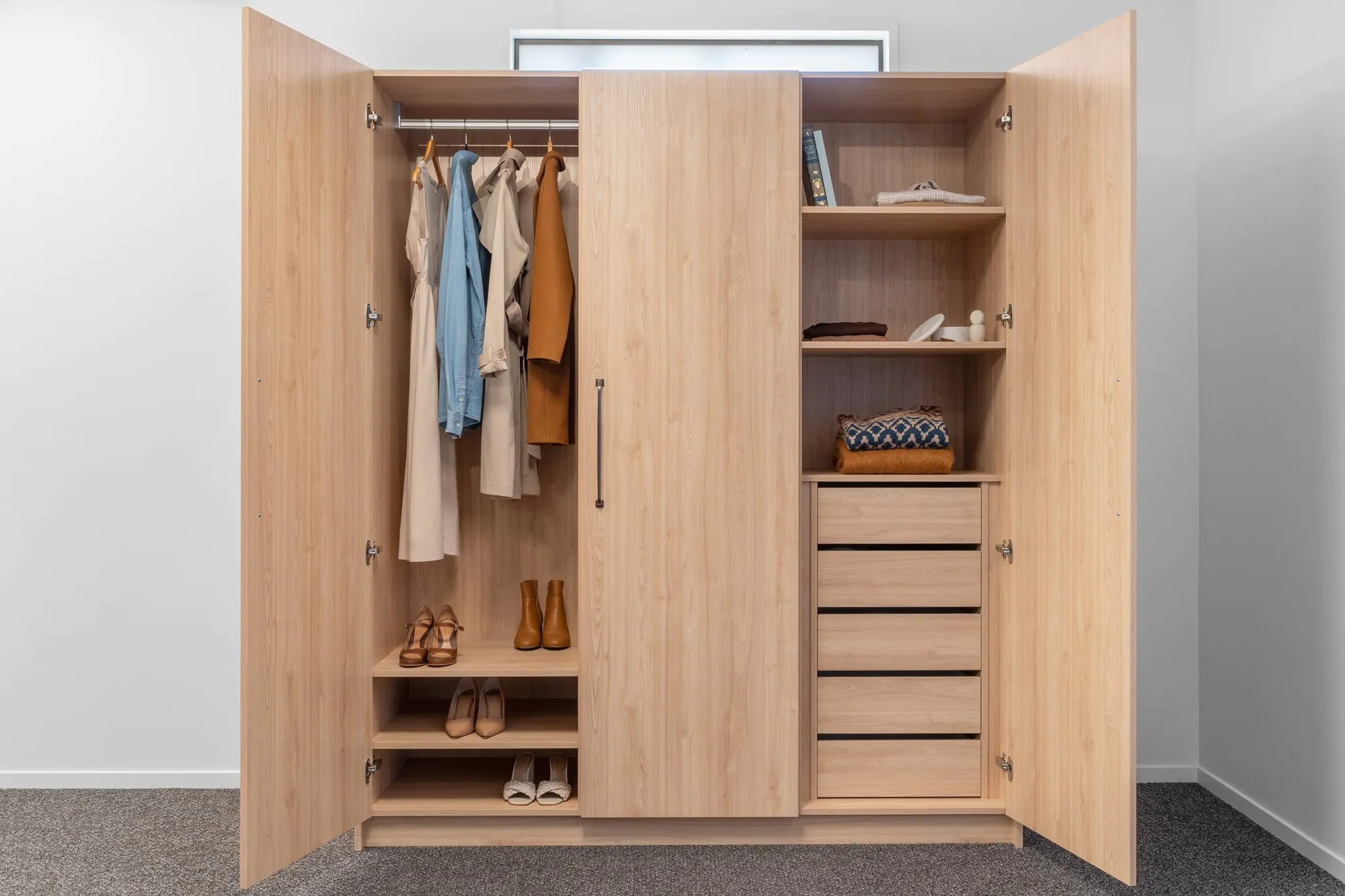
A new, popular solution is Viva, designed for homes that don’t have in-built wardrobe space. The premium unit is complete with back panels and doors, and can be installed by the Boston Wardrobes’ team with minimal preparatory work.
The cost varies depending on your design choices, but in the showroom, it’s easier to make a decision by interacting with the physical products.
The consultation can be done over the phone, but Angela recommends a visit to the showroom at some point during the process as it allows you to see every product first-hand and refine your needs. “Some people prefer to talk on the phone or have us come out to their home first, but trust me, save yourself the time and come into the showroom, it is absolutely worth the effort.” Angela adds.
Once your dream design has been prepared, a 50% deposit ensures it becomes a reality.

Step 3: Home visit
With the design agreed, the designer will complete a final in-home measure to refine the details and discuss any preparatory work.
The correct measurements are crucial, so Boston Wardrobes uses laser equipment to ensure the accuracy of the measurements. At this stage, they check door openings, flooring, and even walls to ensure the installation goes smoothly.
“This is also the time we use to pick up things that may have been missed, such as angled ceilings or walls, attic spaces and manholes, power points, and windows,” Angela adds.
The consultant will also give you a good idea of the preparation work that will need to happen ahead of the new wardrobe being installed. It can include removing any existing shelving and doors, touching up plastering and painting, preparing flooring, and assessing lighting and electricals.


Step 4: Installation
With preparation complete, Boston Wardrobes will be in touch to confirm your ideal installation date. With the aim of ensuring all rooms are done at the same time, the time they will spend varies, and can take anywhere from half a day to two full days.
Due to the bespoke nature of their solutions, there is usually some cutting and assembly required, but Angela notes this has often been cause for compliments. “Our fabulous installers are very thorough at cleaning up after themselves. We are often complimented on their tidiness, friendliness and efficiency.”
Boston Wardrobes has been reliably supplying both residential and commercial markets for decades. “We work with developers, architects and designers, helping to add value through our experience, due to the specialised nature of wardrobe design.”
For new builds and renovations, Angela highly recommends starting the storage solution process at the planning stage of the project to ensure you are working with the best space possible.
“Our experience, personalised process and 10-year quality guarantee behind our products should really give our customers the peace of mind that they are working with the best in the business.”
Other articles
May 8, 2024
What’s happening in our wardrobe space: wardrobe design trends
We're diving into the top wardrobe trends that we see shaping the landscape of wardrobe spaces in Auckland
April 7, 2024
The value of wardrobe storage in multi-unit residential interior design
A well-organised space is crucial to a sense of serenity at home, so creating the ideal storage solutions in multi-unit residential builds needs an expert hand.
March 8, 2021
How much will a new wardrobe cost?
Without a doubt our most frequently asked question, answered in great detail
Wardrobe design rules from the experts
Wardrobe design rules from the experts
When you’re ready to take the plunge and start designing your dream wardrobe, it’s good to start with a solid wardrobe design strategy to ensure your new wardrobe meets all of your needs. Here are our top wardrobe design considerations to keep in mind.
What are the must haves?
First up, time to take stock. Have a think about the items in your wardrobe: are you the queen of shoes, the king of suits or the ace of designer handbags? Do you have more clothing that needs hanging or will shelves serve you better? Do you have lots of long coats or gowns? What do you need to store in drawers? Will you be sharing the wardrobe? All of these questions will help you to determine what sort of structure your wardrobe design should have. It’s also worth considering what works and what doesn’t work in your current wardrobe.
How much space do you have?
Regardless whether you are working with an existing space or building or renovating, the space will need to be assessed and accurately measured. Keep note of power points, windows, doors, ceiling height, door jambs etc. At Boston Wardrobes, we are experts at making the very best use of any space, but there are guidelines to how much space is ideal. These are our recommended minimum dimensions for optimal wardrobe design:
- 1800mm length per person (2400mm for walk-in or walk-through wardrobes)
- 600mm internal depth (suit jackets and coats require at least this)
- 400mm shelf depth and width (folded garments are typically 350mm wide/deep)
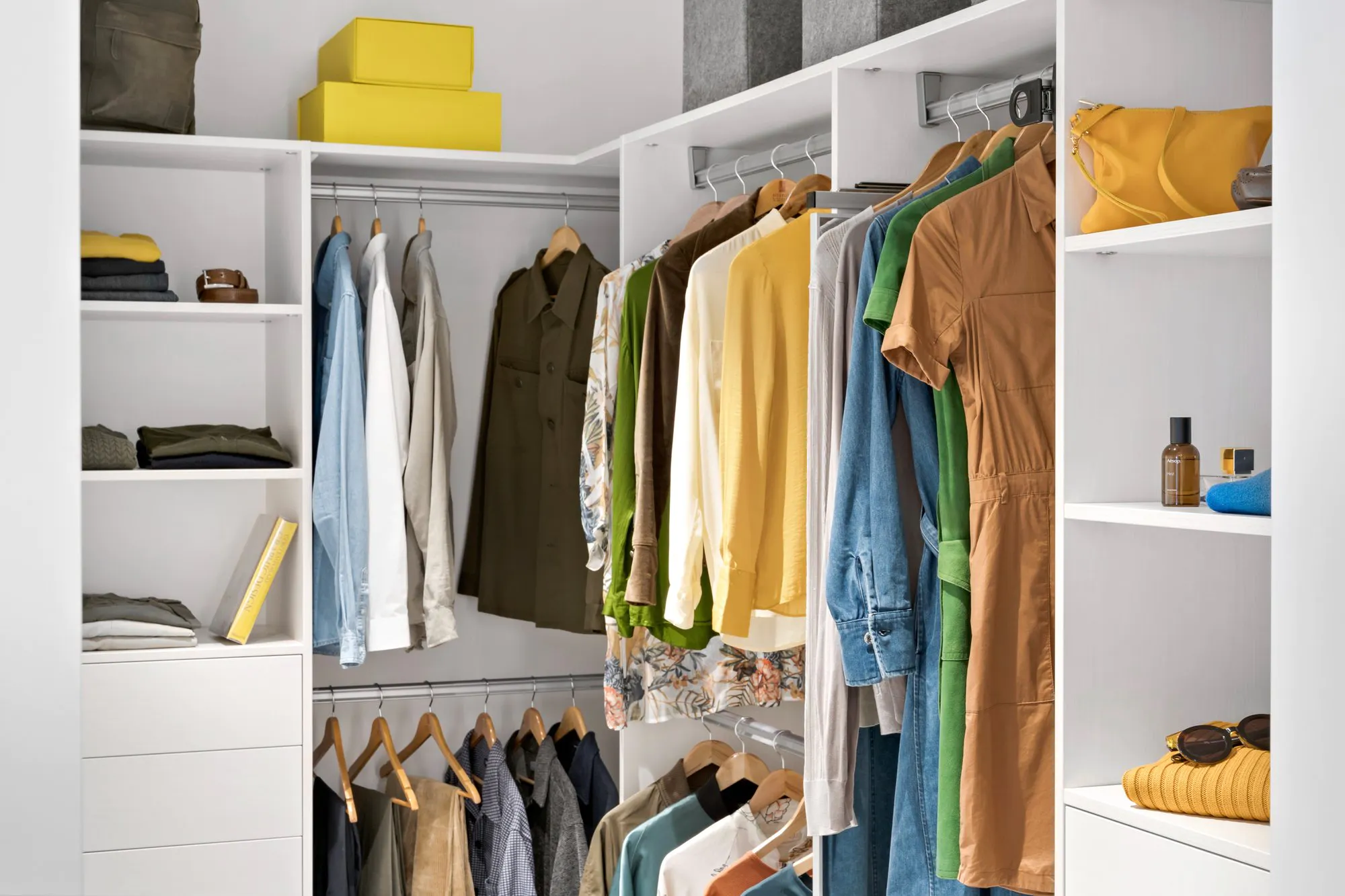
Wardrobe design basics
The main components of wardrobe design are as follows
Hanging space
Usually you would have a mixture of long hang, short or half hang and possibly three-quarter hang, your wardrobe design will be different depending on what you need to store. If two people will be sharing the wardrobe, each would ideally have their own hanging space.
Shelving
Shelves are great for jeans, jumpers, t-shirts, and any items you want to store folded. Shelf height is a standard 400mm but can be adjusted according to your requirements, for example if you have lots of handbags you need to store. You can also store smaller items on shelves by adding baskets or containers.
Drawers
Storing underwear, socks, gym clothes and other smaller or delicate items might be best in a drawer. Drawers come in multiple depths and can be from 400mm to 1200mm wide. They can be open topped, push-to-open or have handles. All of the drawers at Boston Wardrobes come with Hettich runners and a soft-close. Keep in mind that drawers are one of the more expensive components of wardrobe design, so adding or removing drawers will impact the overall budget.
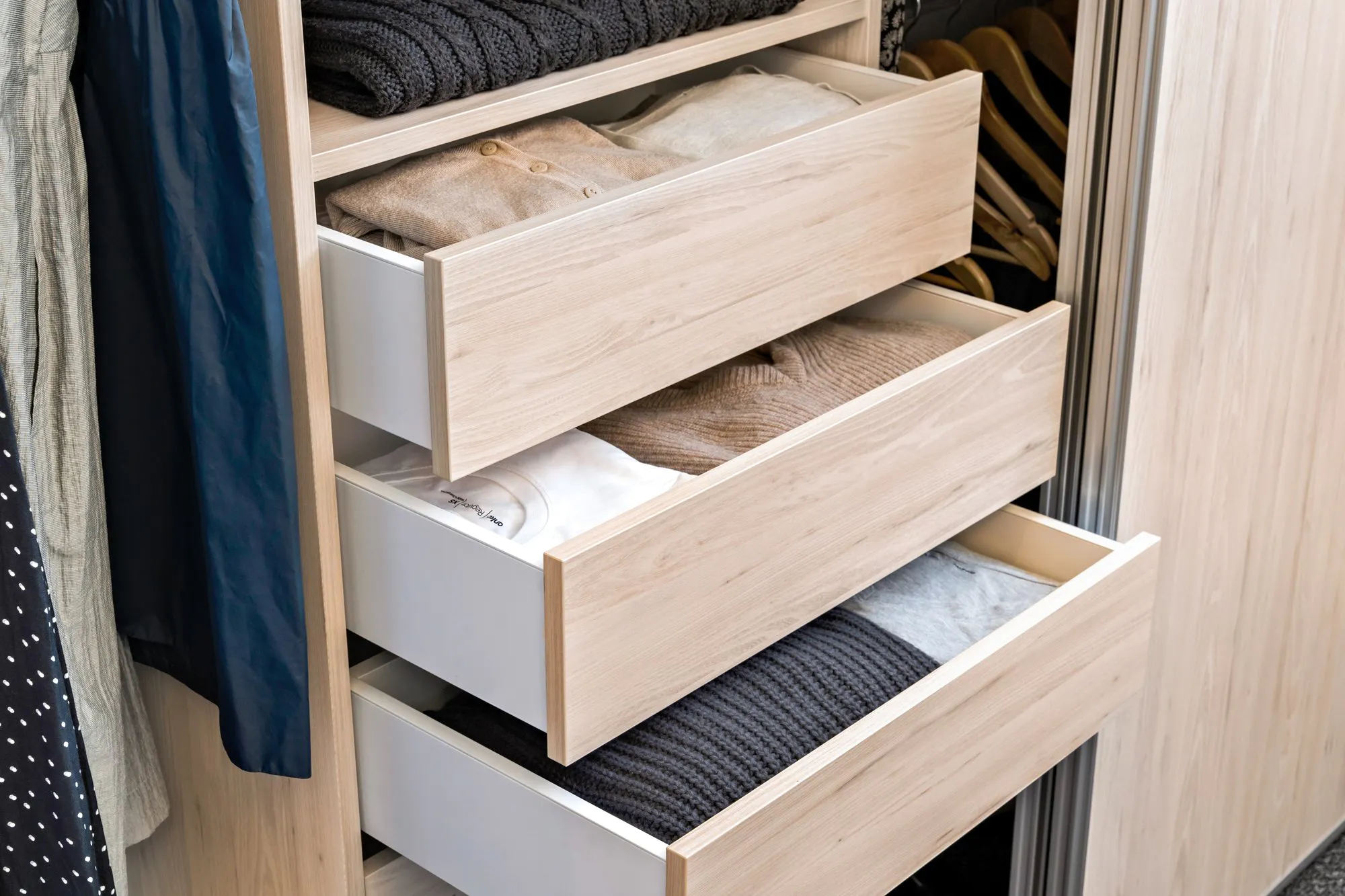
Shoe space
Having specific space to store your shoes not only helps to organise your wardrobe, but also to protect your shoes. There are several options for this including shoe shelves, shoe drawers and, in some ranges, shoe racks. You can have them running along the bottom of the space or dedicate a vertical space to them. This will depend on how much space you have to work with, how many shoes you have and, of course, your personal preference.
Accessories
Finishing touches for your new wardrobe design could include a full length pull-out mirror, bespoke pull-out trouser racks, belt or tie racks, hidden jewellery drawers, or LED lighting. These accessories will ensue all of your items are stored beautifully, with everything immediately accessible and easy to see.
Doors
Adding doors to your brand new wardrobe design will keep your space looking neat and tidy and protect your clothes from dust. You can choose sliding wardrobe doors, bi-fold or hinged. Available floor space will play a key role in this decision, as will access requirements, whether this is a walk-in, walk-through or reach-in wardrobe, and technical details such as door jamb dimensions. What are door jambs? They are the wooden framing around door openings. Most of our doors require door jambs.
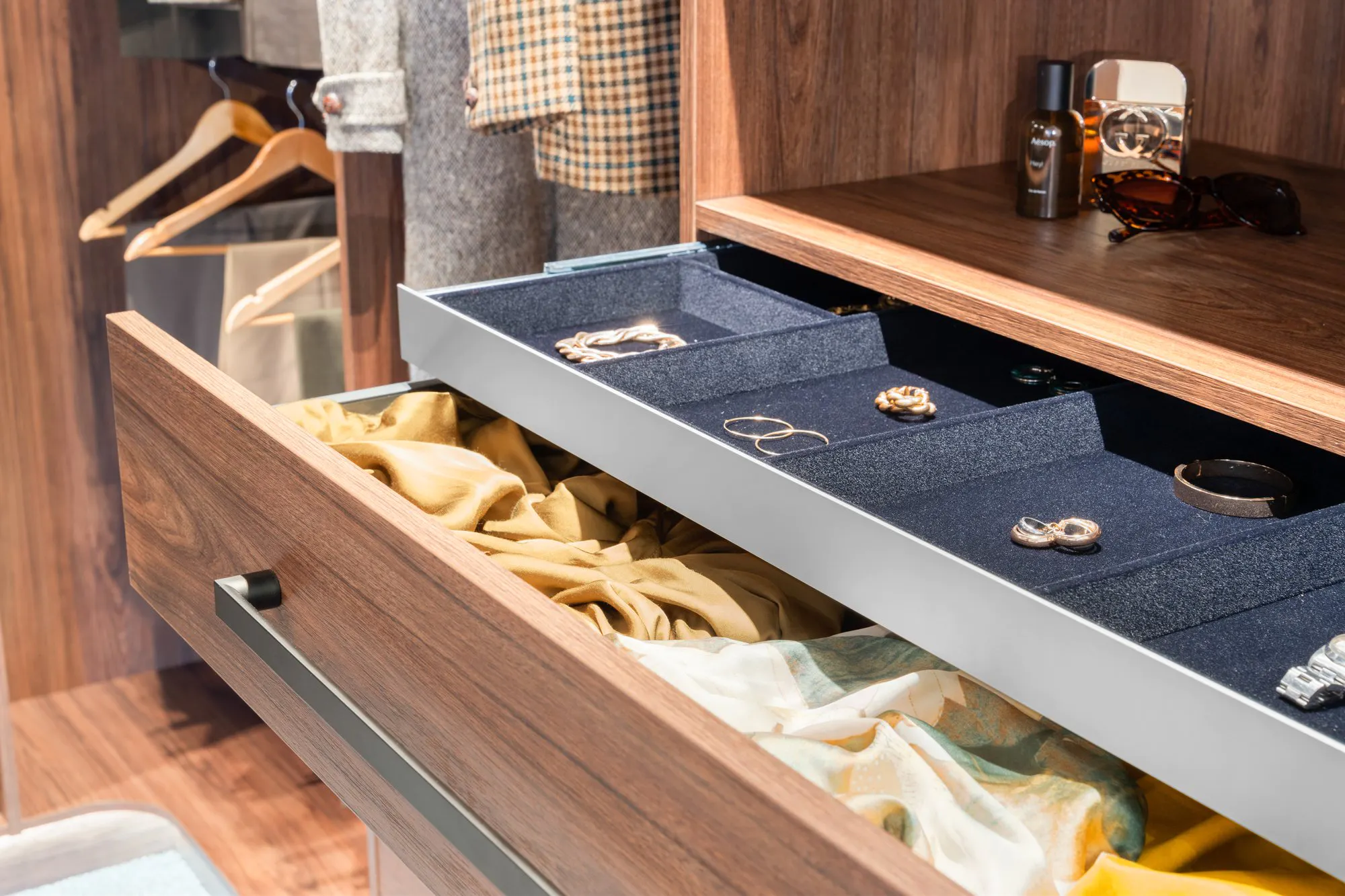
Materials
Now it’s time to decide on how you’d like your wardrobe to look. Finish your wardrobe design in a luscious, textured woodgrain, opt for a block colour to complement your bedroom palette, or choose a minimalist white. Would you like your wardrobe to have back panels on it? Or perhaps you could make the back wall shine through with a pop of colour or a beautiful wallpaper. The possibilities are endless and wardrobes need not be standard and boring, we want you to fall in love with your wardrobe every day!
Next Steps
Ready to talk wardrobe design and wardrobe doors? We can’t wait! Bring your measurements + photos or plans into our beautiful Grafton showroom to see the dozens of options available, and we can start crafting your perfect wardrobe immediately. If you need help measuring, check out our handy guide below.
At Boston Wardrobes, we are passionate about helping homeowners create smarter, more functional spaces in their home. We have 35 years experience designing and building wardrobes and doors for Aucklanders
Other articles
May 8, 2024
What’s happening in our wardrobe space: wardrobe design trends
We're diving into the top wardrobe trends that we see shaping the landscape of wardrobe spaces in Auckland
April 7, 2024
The value of wardrobe storage in multi-unit residential interior design
A well-organised space is crucial to a sense of serenity at home, so creating the ideal storage solutions in multi-unit residential builds needs an expert hand.
March 8, 2021
How much will a new wardrobe cost?
Without a doubt our most frequently asked question, answered in great detail
Wardrobe storage solutions & tips
Wardrobe storage solutions & tips
At Boston Wardrobes, we love to make your mornings easier and more enjoyable by giving you beautiful and well-organised wardrobe storage. When your clothes are organised and easily accessible, you save time looking for things and avoid the frustration of not being able to find the items you want. Effective wardrobe storage will also extend the life of your clothes by protecting them and keeping them looking good.
Start with what you have
Clear it out!
The best way to get the most out of your wardrobe storage is to do a regular clear-out. This ensures space isn’t being taken up by clothing that isn’t being worn, giving your clothes more room (leading to better organisation), and making space for any new season finds.
Categorise
Group your clothing by category so that you can store like with like. Tops, jumpers, pants, gym clothes, should all have their own shelf or drawer inside your wardrobe. Grouping hanging items together also helps to keep everything organised; shirts, blouses, skirts and jackets should be hanging in groups together.
Keep it in sight
Out of sight, out of mind! Remember that if you can’t see an item, you are more likely to forget about it. Keeping everything within eye sight will not only make it easier to find things, but it will ensure you are getting more wear out of your whole wardrobe.
In-season wardrobe storage
Consider storing clothing away seasonally. Taking your heavy winter coats, jumpers and jackets out of your wardrobe when they are not in use will free up storage space for the clothes you are wearing right now. The more space you have in your wardrobe, the easier it will be to find what you need!
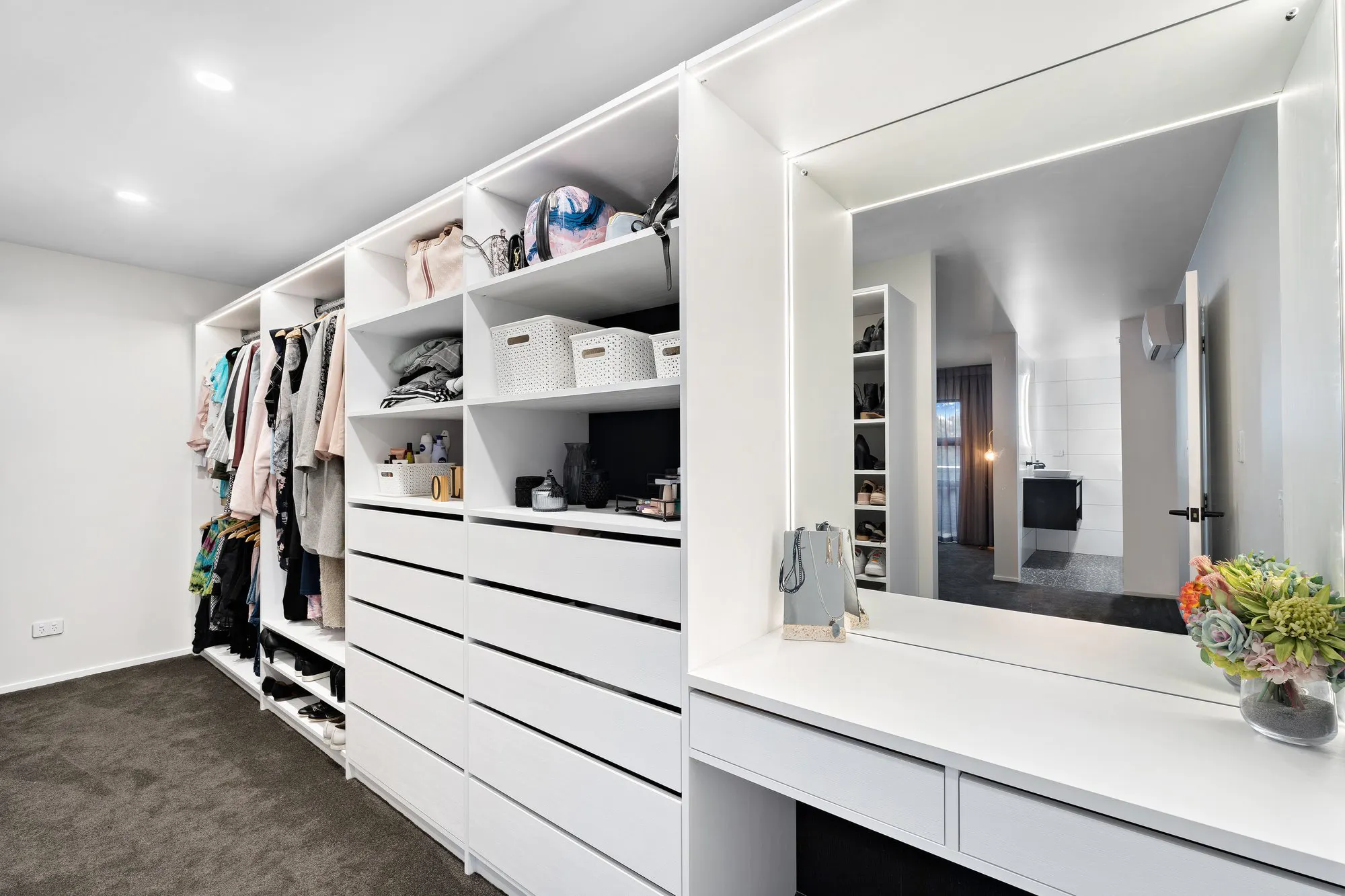
Useful additions to your wardrobe storage space
- Drawer dividers are an inexpensive way to help keep smaller items such as underwear, bras and socks organised and easier to access.
- Choose slimline clothes hangers to maximise hanging space in your wardrobe. Wooden and velvet are the best for your clothes.
- Hooks can be added for storing scarves, belts and bags. At Boston wardrobes we also have a range of wardrobe accessories that address these items specifically, making them even easier to store.
- Shoes can be better stored on a shoe shelf. Choose from one of the multiple shoe options at Boston Wardrobes for the most beautiful shoe storage available. Pro tip: fit more shoes on a shelf by placing each pair with one shoe facing in and one facing out.
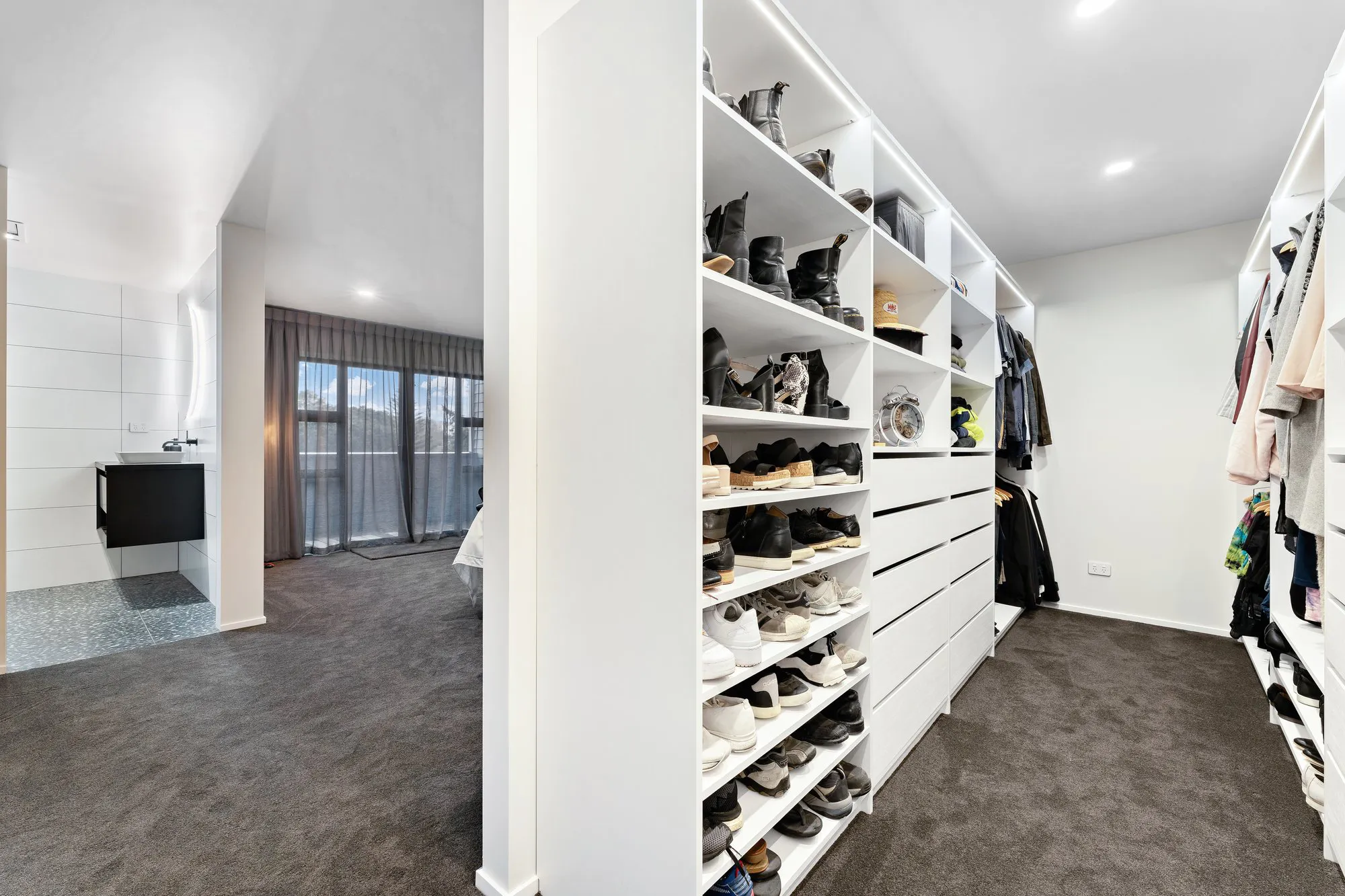
Shoe space
Having specific space to store your shoes not only helps to organise your wardrobe, but also to protect your shoes. There are several options for this including shoe shelves, shoe drawers and, in some ranges, shoe racks. You can have them running along the bottom of the space or dedicate a vertical space to them. This will depend on how much space you have to work with, how many shoes you have and, of course, your personal preference.
Accessories
Finishing touches for your new wardrobe design could include a full length pull-out mirror, bespoke pull-out trouser racks, belt or tie racks, hidden jewellery drawers, or LED lighting. These accessories will ensue all of your items are stored beautifully, with everything immediately accessible and easy to see.
Doors
Adding doors to your brand new wardrobe design will keep your space looking neat and tidy and protect your clothes from dust. You can choose sliding wardrobe doors, bi-fold or hinged. Available floor space will play a key role in this decision, as will access requirements, whether this is a walk-in, walk-through or reach-in wardrobe, and technical details such as door jamb dimensions. What are door jambs? They are the wooden framing around door openings. Most of our doors require door jambs.

Vertical space in your wardrobe
Does your current wardrobe storage space only have a hanger bar? Many houses in New Zealand were built with minimal regard for wardrobe storage. The standard in most older houses is the basic shelf and rail. You can better utilise the vertical space by adding hanging organisers and raising shelves.
A professional wardrobe storage solution
When you need a wardrobe storage solution that efficiently and beautifully meets all of your unique needs, it’s time to think about a professional approach. Talking to a wardrobe designer will help you identify the gaps in your current wardrobe storage, and together you can get to a bespoke wardrobe design that ticks all of the boxes.
If you are ready to take the next step in your wardrobe journey, Boston Wardrobes has Auckland’s largest wardrobe showroom. Come in to experience, see and feel all of the different types of wardrobe storage solutions and wardrobe doors we have on offer. Our wardrobe experts would love to help you decide which wardrobe system is right for you.
Other articles
May 8, 2024
What’s happening in our wardrobe space: wardrobe design trends
We're diving into the top wardrobe trends that we see shaping the landscape of wardrobe spaces in Auckland
April 7, 2024
The value of wardrobe storage in multi-unit residential interior design
A well-organised space is crucial to a sense of serenity at home, so creating the ideal storage solutions in multi-unit residential builds needs an expert hand.
March 8, 2021
How much will a new wardrobe cost?
Without a doubt our most frequently asked question, answered in great detail
Wardrobe systems for small spaces
Wardrobe systems for small spaces
Apartment living is increasingly becoming part of Auckland life as councils rewrite suburban plans and allow more multi-story buildings to sprout up around main arterial routes.
Smaller spaces require a clever rethink on how to manage storage to balance both function and form. Get it wrong, and you risk creating an impractical space that creates unnecessary stress every time you use it.
Thankfully, our design experts have fantastic experience in this area and can guide you through the process to make the most of the limited space you have. To get you started, here are three ideas to consider when starting a project where space is at a premium.
Understand the limitations you have – other than space
Smaller spaces can have unique restrictions, reducing the type of wardrobes you are able to install. For instance, our wide range of floor mounted wardrobes are a common solution for apartment dwellers who are not able to, due to construction style or body corporate rules, fix items directly to the walls.
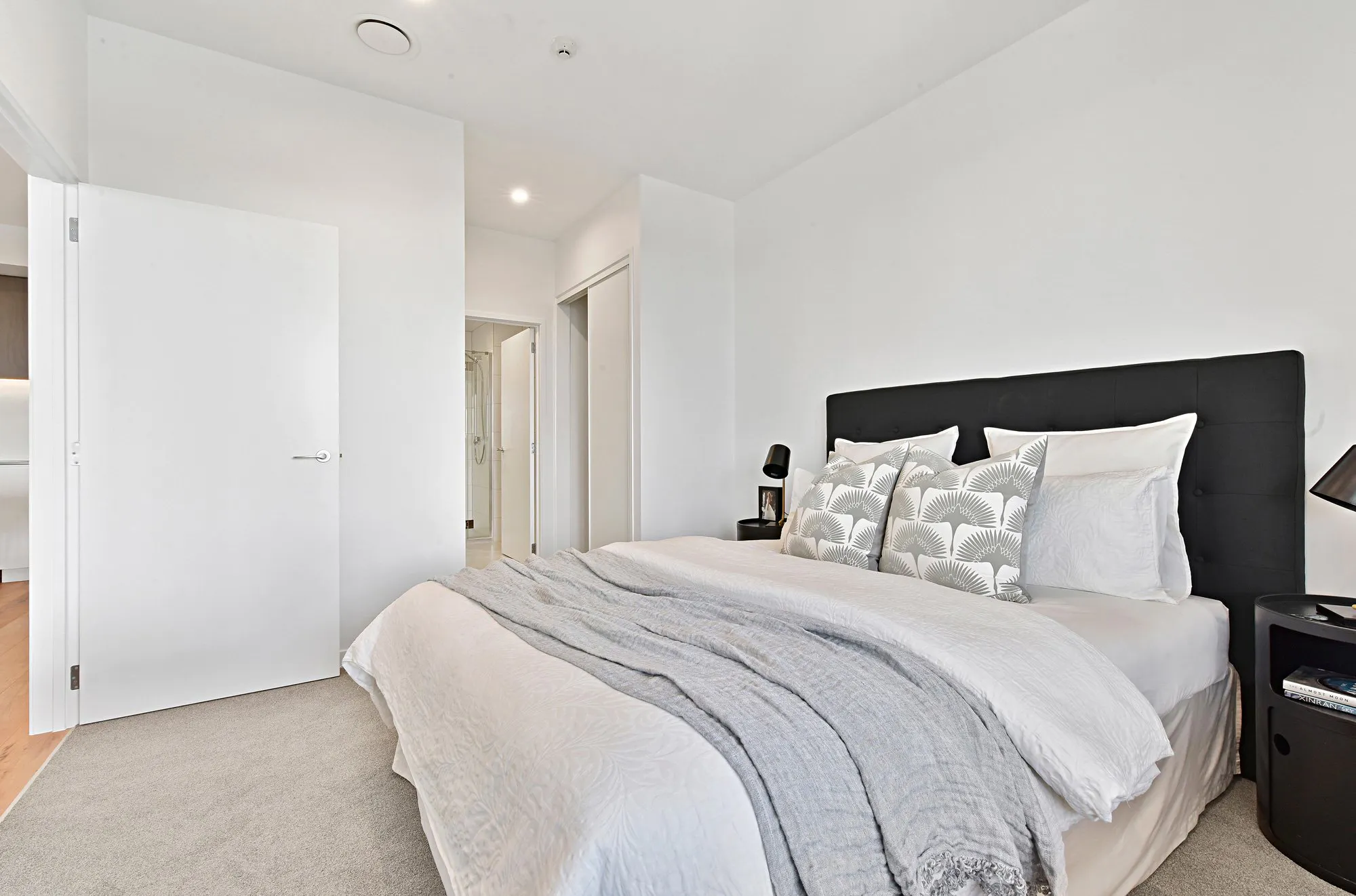
Simple is good – super simple is even better
Smaller spaces will require clever design thinking to achieve what larger spaces easily cater for, such as space to hang both long and short items together. Room layout needs to be considered carefully as well, with less wall space potentially available and windows to work around.
Perhaps the best solution has shelving or drawer units sitting alongside a full length hanging wardrobe space, because windows mean you can’t extend the wardrobe space any further. You can also think about a separate storage area for out-of-season outfits, as not using your wardrobe to store all of your clothes at the same time will help free up space.
Compromise is not a word most want to include in creating their ideal wardrobe but in smaller spaces, this is often the theme of the design process. Through thoughtful compromise, we can create bespoke designs that will increase the usability of even the trickiest of spaces.
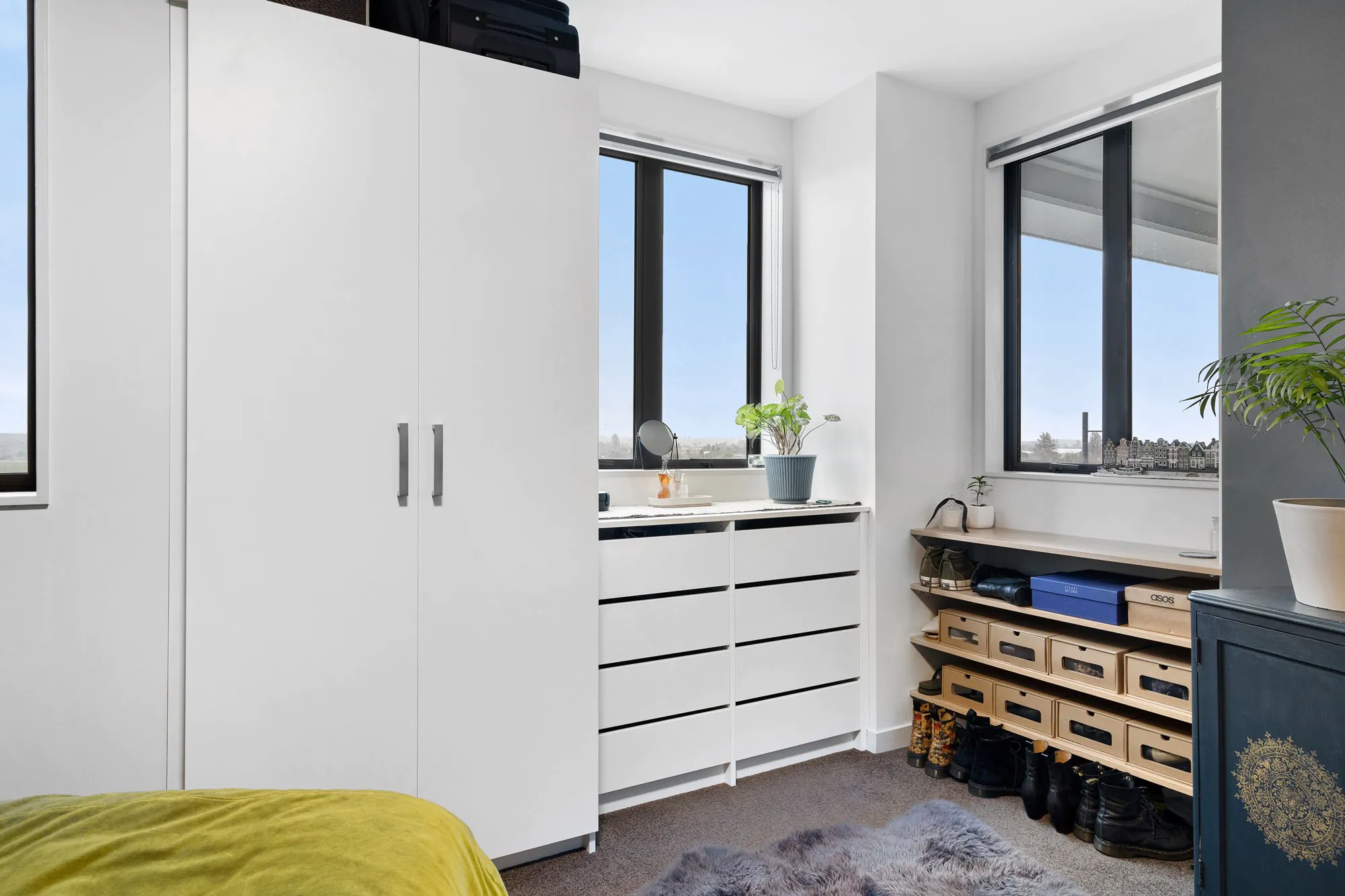
The Showroom is Your Friend
Thankfully the Boston Wardrobes Showroom experience will make the process of compromise an easy one. To make the best decision, we feel you need to see and feel the options you are deciding on. Especially when it comes to designing for smaller spaces.
Arrive with an idea of the measurements you are working with. Then, our wardrobe design experts will walk you through all the options to make it as easy as possible to decide on the ones that work for you and your space, however small it may be.
Other articles
May 8, 2024
What’s happening in our wardrobe space: wardrobe design trends
We're diving into the top wardrobe trends that we see shaping the landscape of wardrobe spaces in Auckland
April 7, 2024
The value of wardrobe storage in multi-unit residential interior design
A well-organised space is crucial to a sense of serenity at home, so creating the ideal storage solutions in multi-unit residential builds needs an expert hand.
March 8, 2021
How much will a new wardrobe cost?
Without a doubt our most frequently asked question, answered in great detail
Creating the perfect walk-in wardrobe
Creating the perfect walk-in wardrobe
You’re dreaming of the perfect walk-in wardrobe, but you have no idea where to start – we hear this a lot. This article will take you through the six steps we commonly work through with our clients to help them achieve their goals within the limitations of their space and budget.
1. How much space do you have?
First up, let’s get clear on the space you have for the wardrobe. Whatever happens, this is going to be one of the hard limits to your creation, as you only have so much space to work with. Begin measuring up to create a rough plan on paper.
For some, this could mean getting out the measuring tape – for others it could be looking at the building plan to see how much capacity has been allowed for. Either way you need to end up with some shapes on paper that relate to the space for your new dream walk-in wardrobe.
2. How should you use the space?

Now, let’s work on how you want to use the space. It’s not practical to fill the whole space with storage and leave no room for you. So it’s good to think through what you want to do in the space as well as what you need to store.
For instance, you may want it to be a place to put on makeup, or have enough space to check out your outfit in a full-length mirror. Where the space needs to cater for more people than just you, make sure you check in with all parties involved to create a list of needs to suit everyone.
3. Types and amount of clothes that need storage

Let’s look at the amount and type of items you want your walk-in wardrobe to contain. Our clothes are as individual as we are – those in corporate life will have storage needs that differ from those with a more casual work attire.
Shoes and accessories could be a small part of someone’s wardrobe but a major part of someone else’s. It goes without saying that women and men have different needs too. For instance, the length of a lot of women’s clothing is generally a lot longer than most men’s.
Take your time to make a list of the type of clothes requiring storage. Don’t worry too much about if it will all fit – we can take care of that later – just build a complete list.
4. Don’t forget items that may not immediately seem logical
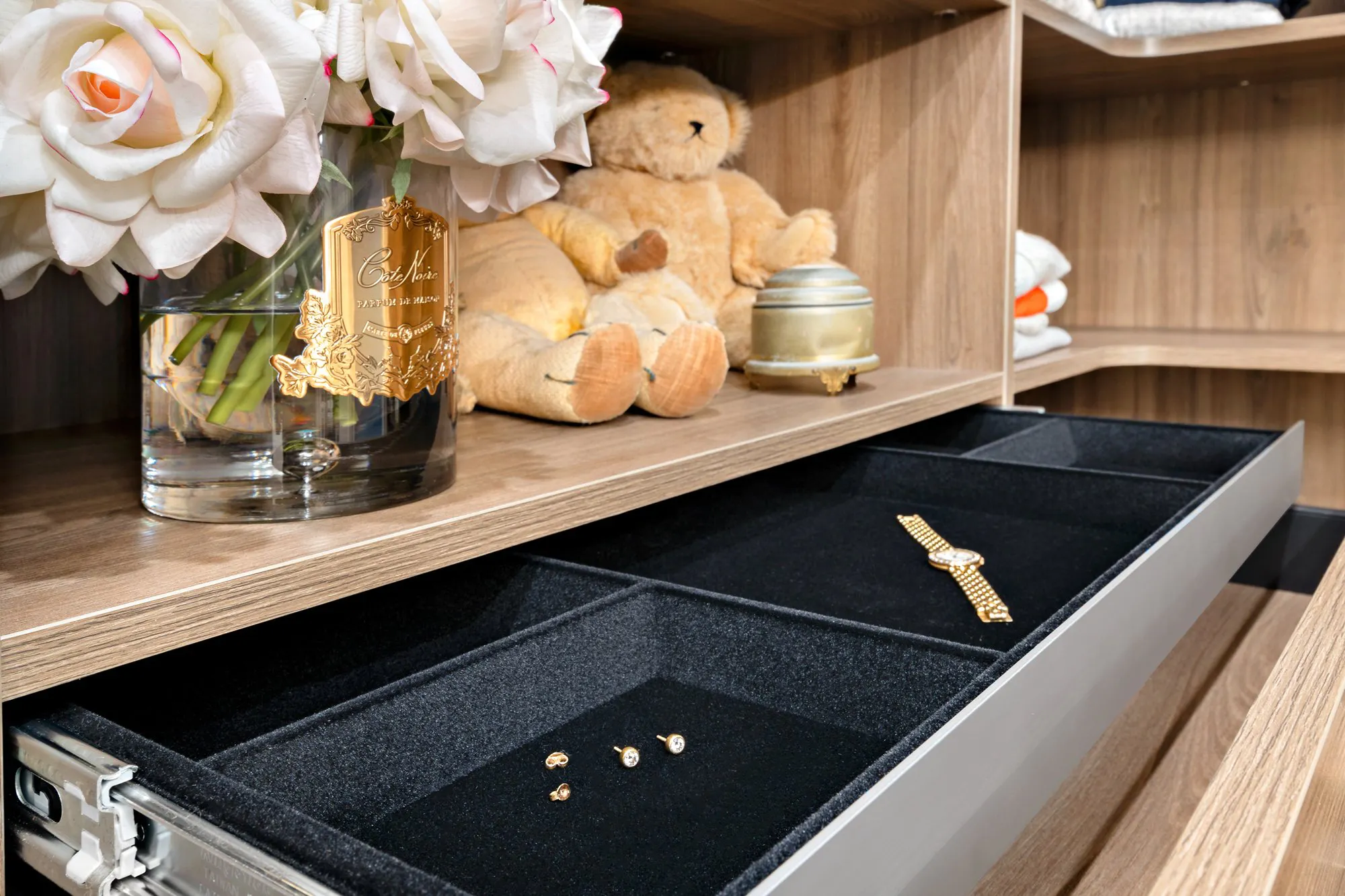
It’s not all about clothes. For example, a well designed but hidden jewellery tray could put the finishing touch on your ideal walk-in wardrobe. Allowing for space to store bed linen could take up a small amount of room but save you countless trips up and down stairs.
The light you have to work with in your walk-in wardrobe needs to be thought through too. Windows may need to be frosted to protect privacy and ensure clothes are not harmed by direct sunlight. The type and amount of artificial lighting needed will depend on how you want to use your wardrobe space.
And finally, the dream might be about creating enough space for you to have a moment of peace away from the family. A place to sit down, apply some makeup, pick the right clothes for the occasion and collect yourself before heading out.
Think of these first planning stages as the foundation of your project. Take your time to work through the steps, building a solid understanding to support your wardrobe project.
5. Move from plans to options – with the help of the Boston Wardrobes Wardrobe Design Showroom
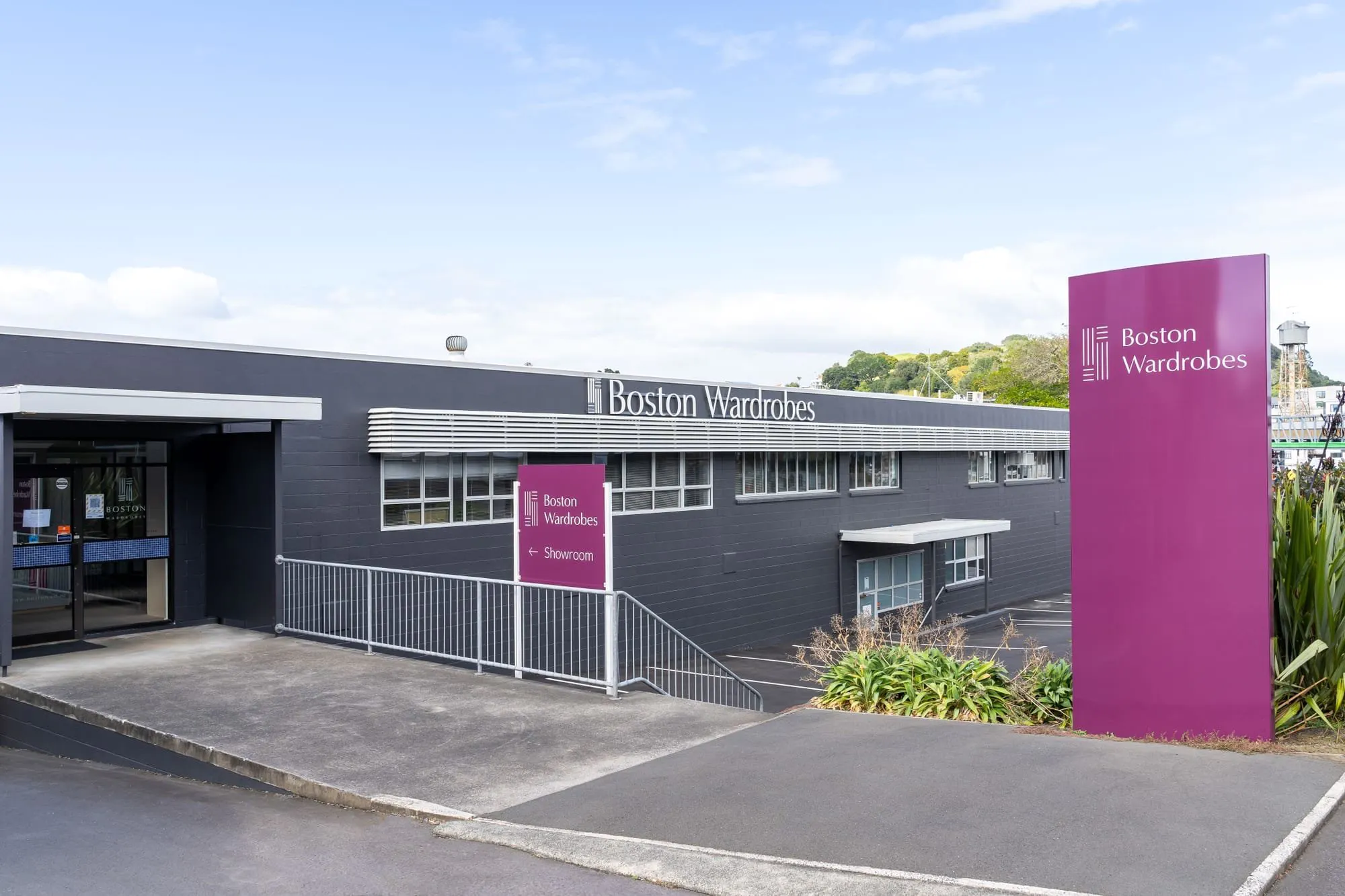
It’s time to move from thinking and planning to seeing and discovering the wide range of options available to you. The Boston Wardrobes Showroom is the ideal next step to make your dream a reality.
With the help of one of our wardrobe design experts, you can see multiple walk-in wardrobe examples in one place, deciding exactly what options suit your requirements.
- Not sure how many drawers you need? How big they should be?
- Will 3/4 length hanging work for your suits?
- Should shoes be at eye level or running along the bottom?
- How much room do you need for a sitting makeup station?
- Which accessories will add the most value to your design?
- Will sliding or bi-folding doors be better for the space?
- What colours and finishes will best suit your vision?
We can answer all of these questions while we explore all the ranges available at our Grafton site – New Zealand’s largest and newest wardrobe showroom.
Include the drawer system from one of our wardrobes, a sliding door from another, perhaps a makeup stand from a third – it’s as simple as selecting which parts suit your needs to create the ideal wardrobe for you.
6. Achieving the right balance between Function and Form
The Boston Wardrobe design team are experts at creating a walk-in wardrobe design that looks great, works well and is at the right price point to suit your budget. It’s a collaborative process, so you can expect a few ideas to come your way to help you end up with the perfect solution.
So there you have it – six simple steps to take you from bare space to the welcoming walk-in wardrobe of your dreams.
Time to get the measuring tape out?
Other articles
May 8, 2024
What’s happening in our wardrobe space: wardrobe design trends
We're diving into the top wardrobe trends that we see shaping the landscape of wardrobe spaces in Auckland
April 7, 2024
The value of wardrobe storage in multi-unit residential interior design
A well-organised space is crucial to a sense of serenity at home, so creating the ideal storage solutions in multi-unit residential builds needs an expert hand.
March 8, 2021
How much will a new wardrobe cost?
Without a doubt our most frequently asked question, answered in great detail
Wardrobe design: DIY vs. professionals
Wardrobe design: DIY vs. professionals
Us Kiwis love to DIY – some may even say it’s in our DNA. And while a can-do approach to tackling home projects and renovations is admirable, we’re not all born tradespeople! Sometimes, even if we are not too bad with a level and a hammer, the problem is not so much talent, but time, resulting in friction and frustration in the household around lack of progress.
So, if a wardrobe installation project is on the to-do list for you, there’s a few things you should consider before making a decision about whether to give it a go yourself, or to call in a professional to take care of it for you.
We’ve covered off four key factors to think about before you pull those tools out.
1. Do you have time to DIY?
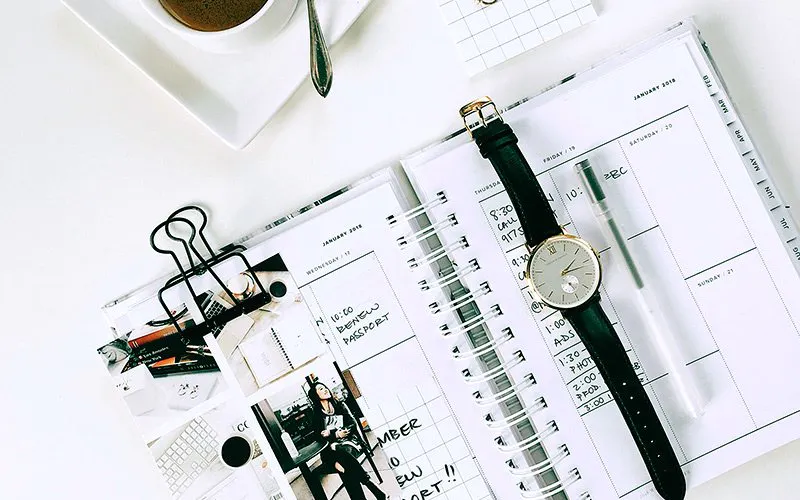
If either you or someone in the household is the handyman type, a DIY wardrobe probably doesn’t seem like too big of a task. In fact it could be the perfect project for a long weekend.
However, unless you are a builder by trade, the best way to go about this is to purchase a kit-set. And while it may seem like a simple project, even this may require more preparation than you realise. Take into account the time you will need to spend:
- Measuring: The correct measurements of your available space are essential so you don’t bring home a well-intentioned purchase that doesn’t quite fit.
- Choosing materials: Check out the quality of the materials closely. Sub-par melamine can warp over time and get damaged during installation. Make sure you check out any wire or hanging components for sturdiness too.
- Hunting for a great deal: Don’t confuse the cheapest option for the best value. At the same time, it pays to shop around to make sure you are getting the best bang for your buck.
- Constructing: Here comes the fun part. Do overestimate the time that constructing your new wardrobe will take. Rushing this part of the process will cost you in the long run.
- Troubleshooting: Allow for unexpected delays that may arise from pre-made parts not quite fitting your space, less than stellar instructions, and power tool malfunctions!
- Cleaning up: Wood + plaster + power tools = vacuum time.
If you think that in fact you don’t have the time, inclination or patience to go ahead with DIY, then call in the pros. While an initial showroom consultation with a sales representative will take around one to two hours, the rest is largely over to them. Once you have received and accepted a design and quote, you’ll need to also allow about a half hour for an in-home measurement, but otherwise there’s no need to invest anymore precious weekend hours!
2. Will you get the quality you are looking for?
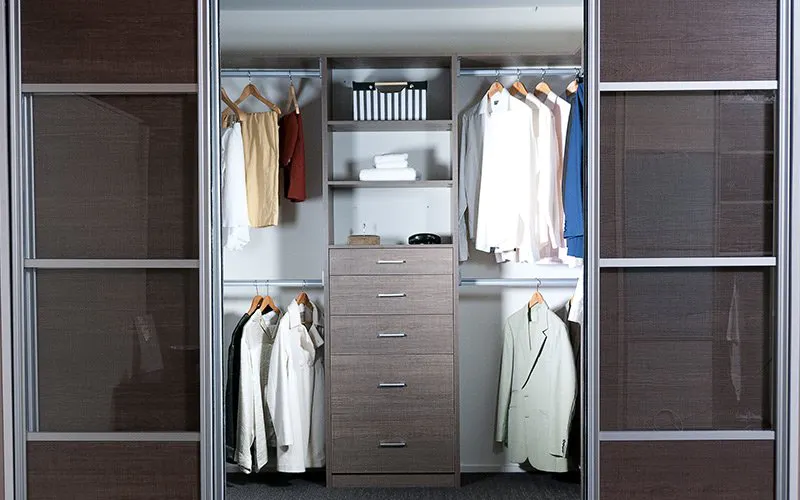
Think about the outcome and overall finish that you’re hoping to achieve. Is this a quick-fix or temporary solution? Or do you want a customised design that perfectly accommodates your needs?
If you’re keen on a kit-set, be sure to spend some time doing your research. Depending on how much you want to spend, the quality of materials and hardware included in kit-sets can vary between products. Generally speaking though, it won’t be outstanding. You will also have less choice when it comes to colours and size, as they’ll often be limited, standardised options. Where this could cause you issues is when you have an unconventional space to work with, or a particular colour scheme you’d like to stick to.
If you think you need something a little more bespoke, a reputable wardrobe company will offer a range of quality materials for organisers and doors that will be highly customisable, with options to suit your budget. The devil is in the detail, so spend some time in their showroom, reviewing their design options and the quality of their fittings, hardware, panels and mirrors, as well as the knowledge of the consultants.
3. Will you be able to make the best use of the space?

While taking a DIY approach does allow you some flexibility in design, you’ll need to get a really clear idea of the space required for hanging and shelving before you start mapping out your wardrobe or purchasing materials. If you are opting for a kitset, you won’t have a lot of room for customisation, so when deciding on which model to buy, have a think about your storage requirements and how you would like to optimise your hanging, shelving and drawer space.
We don’t all have an eye for design, and this is where the services of a professional wardrobe company really come in handy. After all, their main function is, in fact, design. Their job is to assess your individual storage requirements, take into account your available space and design a tailored solution for your needs. If you are renovating, your consultant will also be able to advise regarding any permits or wardrobe allowances your builder should take into consideration, to ensure you avoid any costly mistakes.
Bonus tip: get a guarantee

Remember, a DIY wardrobe might seem like an easy solution to your storage problems, but it may not result in a finish that works long-term, or withstands the test of time. With a professional installation also comes peace of mind – in the form of a guarantee. That means that if any issues crop up, you can pick up the phone and have them taken care of in a timely manner. Always use a reputable company with an established history, and consider their guarantee terms before making your decision.
So, will you be heading to the hardware store this weekend, or will you be handing this project over to the professionals? Hopefully the questions above have helped you get some clarity about the best way to approach your wardrobe project and the benefits that come with investing in the services of a professional wardrobe installation company.
If you have a project that needs a professional eye, get in touch! One of our representatives can take you through the best solutions for your storage requirements.
Other articles
May 8, 2024
What’s happening in our wardrobe space: wardrobe design trends
We're diving into the top wardrobe trends that we see shaping the landscape of wardrobe spaces in Auckland
April 7, 2024
The value of wardrobe storage in multi-unit residential interior design
A well-organised space is crucial to a sense of serenity at home, so creating the ideal storage solutions in multi-unit residential builds needs an expert hand.
March 8, 2021
How much will a new wardrobe cost?
Without a doubt our most frequently asked question, answered in great detail
How much will a new wardrobe cost?
How much will a new wardrobe cost?
If you’re in the market for new storage, it’s likely that one of the first questions you’ll be asking is: how much will a new wardrobe cost me?
You’re not alone. Unlike a lot of other consumer products in the market, wardrobes are “price invisible”. In other words, thanks to advertising, most people have a rough idea of what consumer products are going to cost them – cars, refrigerators, mobile phones, furniture, clothes… But wardrobes? Nope. It’s not surprising that you’ve come in search of an answer.
Why the mystery?
The huge range of designs, sizes, colours, accessories, and technical complexities of the installation of a wardrobe can create a large disparity in pricing between one wardrobe design and another. For example, a walk-in wardrobe in an average house can cost anywhere from $2,000 to $15,000.
What makes this price range so broad, and how can you get an idea of what kind of budget you’ll need to set aside for your own wardrobe?
Well, it all depends on your unique storage requirements and the particulars of your available space. To help you get a better understanding of how far your dollar will go, here are six key factors to consider that will influence the final cost of your new wardrobe.
The images above demonstrate how wardrobes of the same size and basic layout could vary greatly in price. By using a different product range, adding more components, using colour panels, and including accessories, you would end up with very different quotes.
1. Space
Pull out your measuring tape, because the first place to start is to get an idea of what kind of space you are working with. We recommend you aim for a minimum of 1.8 metres for a reach-in wardrobe and 2.4 metres of wall space per person for walk-in wardrobes. 700mm depth will allow for hanging clothing, which can protrude as much as 600mm, with an additional 100mm for easy viewing and access.
Not surprisingly, the size of the available space will not only influence the required organiser components but also the dimensions of the wardrobe doors, which will both in turn affect the price.
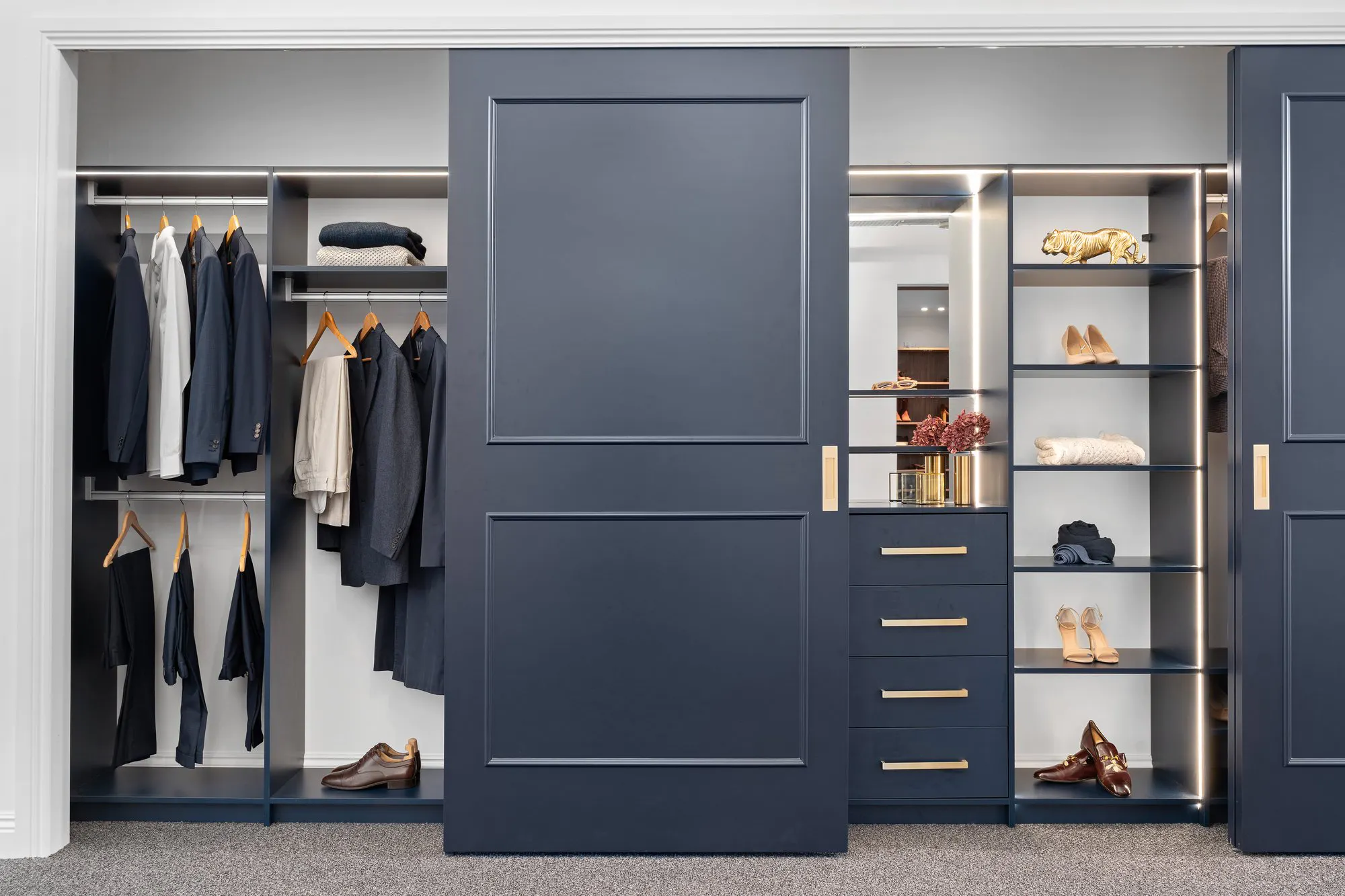
2. Drawers
Have you thought about the amount – and type – of drawers that you need?
How many do you need? How wide should they be? How high? How deep? Open-topped, push-to-open or with handles? All of a sudden, your pricing just got a lot more complex!
These decisions will be dictated by what type of garments you need to store – as well as what budget you are working towards. So have a look at your existing clothing and think about whether drawers are the best storage options for you, and how many you might require.
Undergarments including socks, hosiery, bras and underwear will typically be stored in a drawer, as well as certain types of accessories (scarves, belts) jewellery, and some clothing items (t-shirts, leggings, pyjamas)
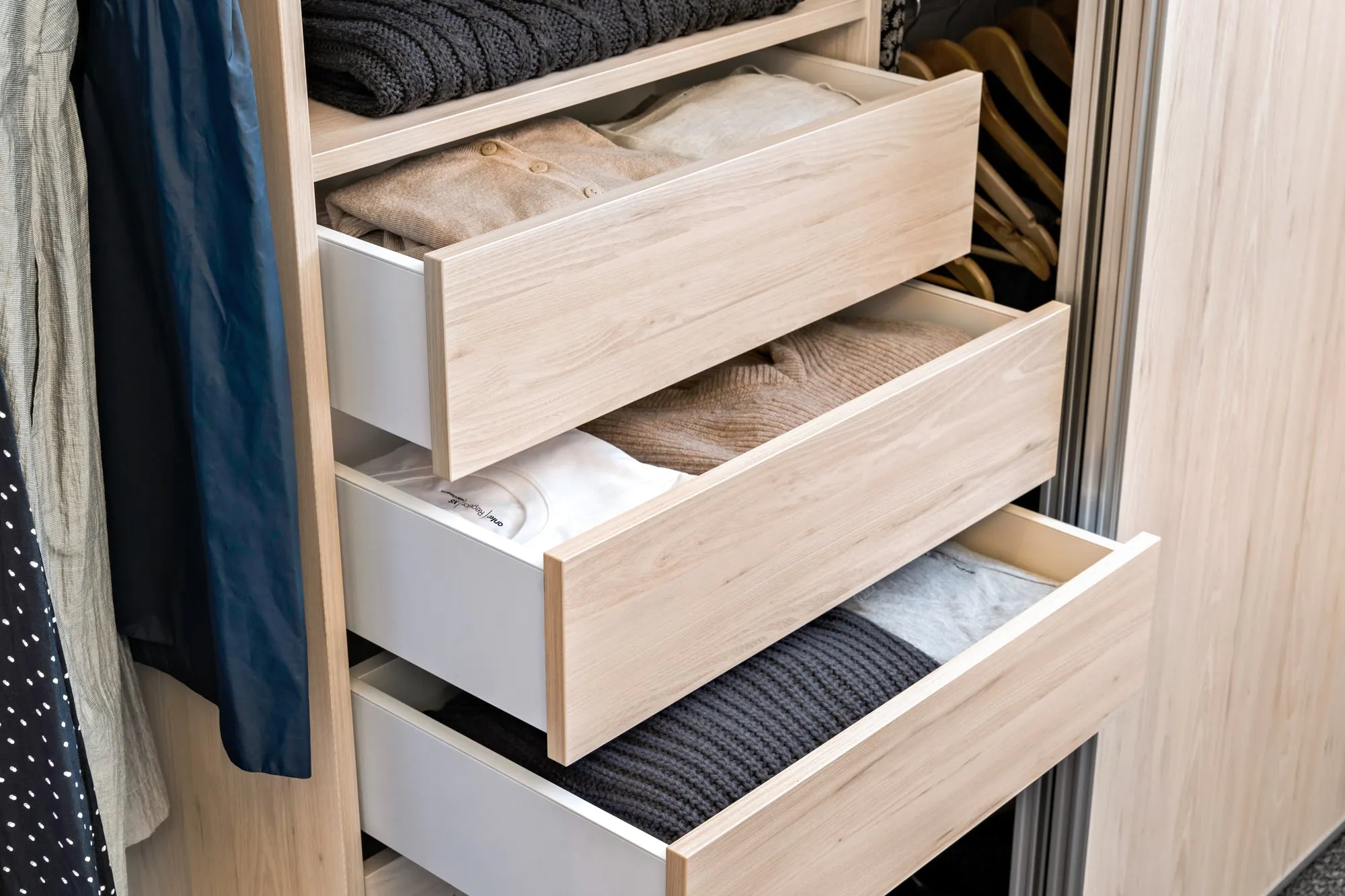
3. Shelves
Jeans, woollen jumpers and sweaters are best stored on open shelves. To give you an idea of storage capacity, you will be able to store two folded piles of clothing on 500mm or 600mm wide shelves, whereas on more narrow 400mm shelves you will only fit one pile.
Shelves have the potential to get a little disorganised, but by planning what will go on each shelf you can organise your space effectively – and avoid accidentally ending up with jumbled piles or other bits and pieces suddenly taking residence in your new wardrobe.
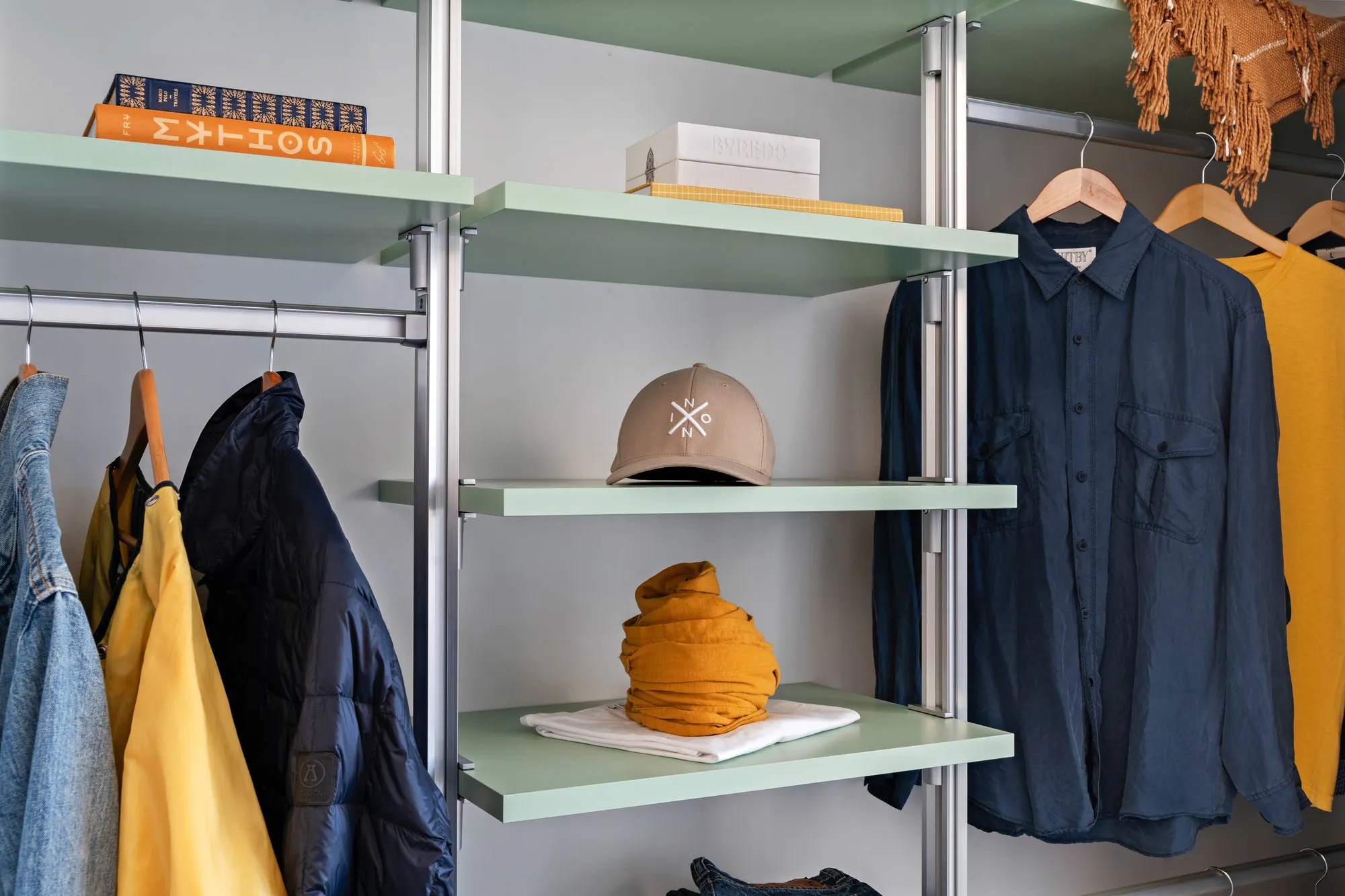
4. Hanging Space
To really optimise your hanging space, a double-hanging set-up is the way to go. This allows you to maximise clothes hanging space by having one rail above another (providing that an overall height of at least 2.1 metres is available). Long hanging space and 3/4 hanging are also handy for winter coats or full-length gowns, and can be set at custom heights depending on your requirements.
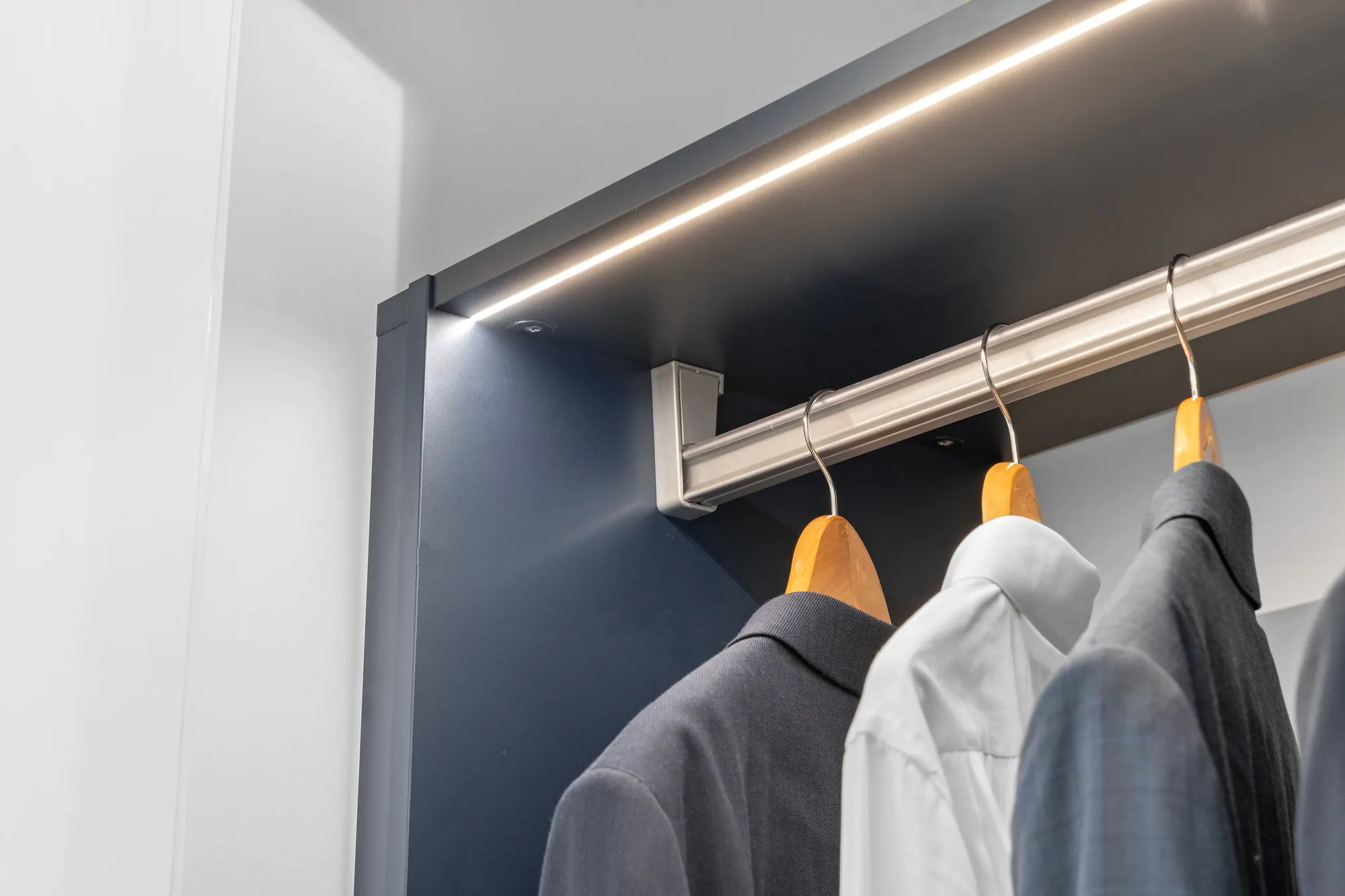
5. Accessories
Do you have an enviable shoe collection, an impressive handbag haul or a selection of ties for every day of the year?
Whatever your fashion indulgence, there are a number of available add-ons for wardrobes which can make organising your space and getting dressed in the mornings much more efficient – belt and tie racks, pull out trouser racks, specialised jewellery drawers, fold away mirrors – the list goes on. These add ons will affect the design and pricing of your wardrobe, but will also improve the overall organisation in line with your needs.
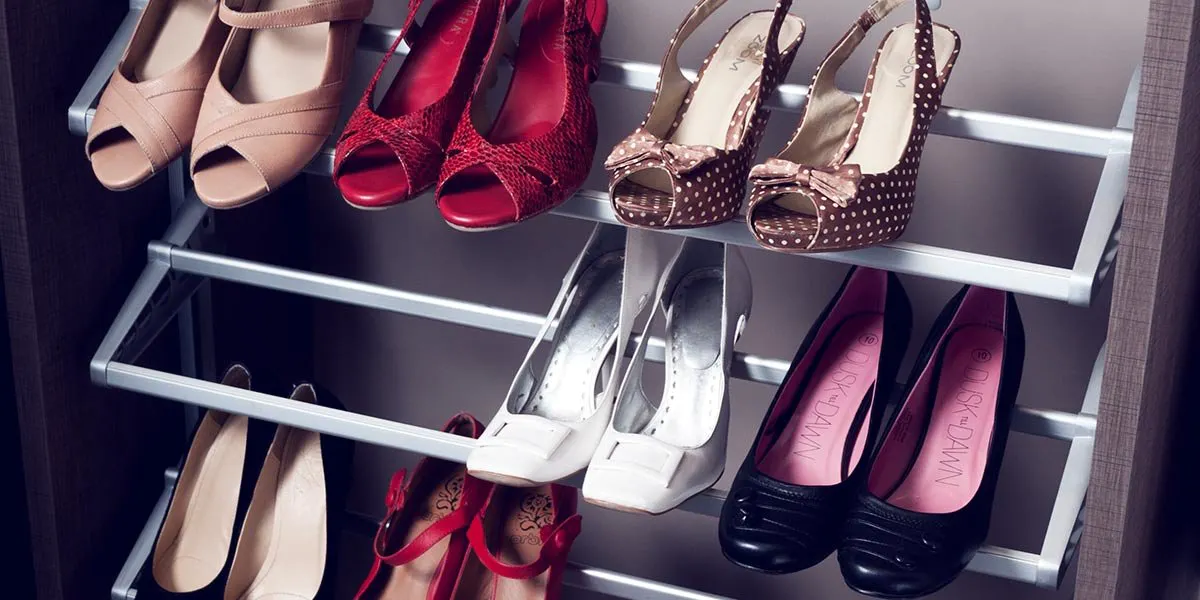
6. Installation costs
Installation costs should also be considered. It’s possible that you may need to employ the services of a builder before having your wardrobe installed. For example, if you need the opening to your wardrobe made larger to get full access to the available space, or if you need to create the wardrobe cavity by building out from an existing wall – so these costs will depend on how complex the space is that you’re working with.
Where do you start?
As you can see, there are multiple factors influencing the cost of a wardrobe, so it’s pretty tricky to give you a ballpark figure until we’ve had a chance to understand all of the variables.
Once you have discussed your particular requirements with your wardrobe sales consultant, you can then start to think about designing within the restraints of your budget.
At Boston, we have a wide range of storage and door solutions suited to all budgets. Organisers can range from the basic efficiency of our wall-mounted Select range, to the stylish elegance of the Innova range, which has the added benefit of easy dismantling if you were to move house. Our range of doors also includes options for all budgets, without ever compromising on quality and durability.
It’s good to keep in mind that whatever you decide, your new wardrobe is going to be a fixture – that is, a permanent component of your home. Quality fixtures are not only solving a problem (lack of storage space or un-practical wardrobe fitouts), but they will ultimately add value to your home. Making sure you choose a reputable company with experienced sales and installation teams will save you money in the long run – do it once and do it right.
If you’re ready to investigate further, we’d love to help. Get in touch today to organise a free consultation at our Grafton showroom.
Other articles
May 8, 2024
What’s happening in our wardrobe space: wardrobe design trends
We're diving into the top wardrobe trends that we see shaping the landscape of wardrobe spaces in Auckland
April 7, 2024
The value of wardrobe storage in multi-unit residential interior design
A well-organised space is crucial to a sense of serenity at home, so creating the ideal storage solutions in multi-unit residential builds needs an expert hand.
December 14, 2023
The stress-free solution to wardrobe storage
As a feature of the home that we interact with every day, the importance of wardrobe storage should not be underestimated
Wardrobe systems in villas & bungalows
Wardrobe systems in villas & bungalows
Architectural design trends have come and gone, but the popularity of classic New Zealand villas and bungalows has stood the test of time.
Owning one of these character-filled homes has become somewhat of an aspiration for Kiwi buyers, with discerning homeowners coveting their antique distinction.
While they can require some extensive upgrades, renovating a villa or bungalow should be a labour of love, and worth the effort to restore some of the home’s most characteristic features, but with a modern twist. If you’re lucky enough to own one, you know how important it is to honour its history and original form when thinking about renovating.
A home steeped in history
Villas first started to appear in New Zealand around the 1870’s. Typical construction was almost entirely of timber with a metal roof. Its distinctive features include one or more bay windows and a decorated veranda or porch facing the street, sash windows, and timber weatherboard cladding – an iconic facade that many have since sought to restore or maintain. They typically had very high, decorated ceilings.
From about 1910, designers and builders started to incorporate bungalow features into New Zealand villas, creating what was to be termed ‘The Transitional Villa’. Typically, early transitional villas featured a pyramid roof (instead of the central valley roof of earlier villas). The roof was also of lower pitch and incorporated the veranda. Other identifiable features included exposed rafter eaves (replacing boxed eaves), wider eaves, and a reduction in veranda decoration that offered a little more understated character than its villa predecessor.
A contemporary comeback
It was around the 1980s that these houses saw a resurgence in popularity. While their exterior character remained endearing, most were in need of upgrading to improve energy efficiency and to reflect the standard expected of 21st century housing.
Since then, renovation of these houses has become a significant part of the building industry’s work, even bringing about businesses established to cater exclusively to these types of homes. After all, it is work that requires an experienced tradesperson who can identify and understand the home’s unique features and problems so as not to lose or compromise the elements that add to its distinctive character.
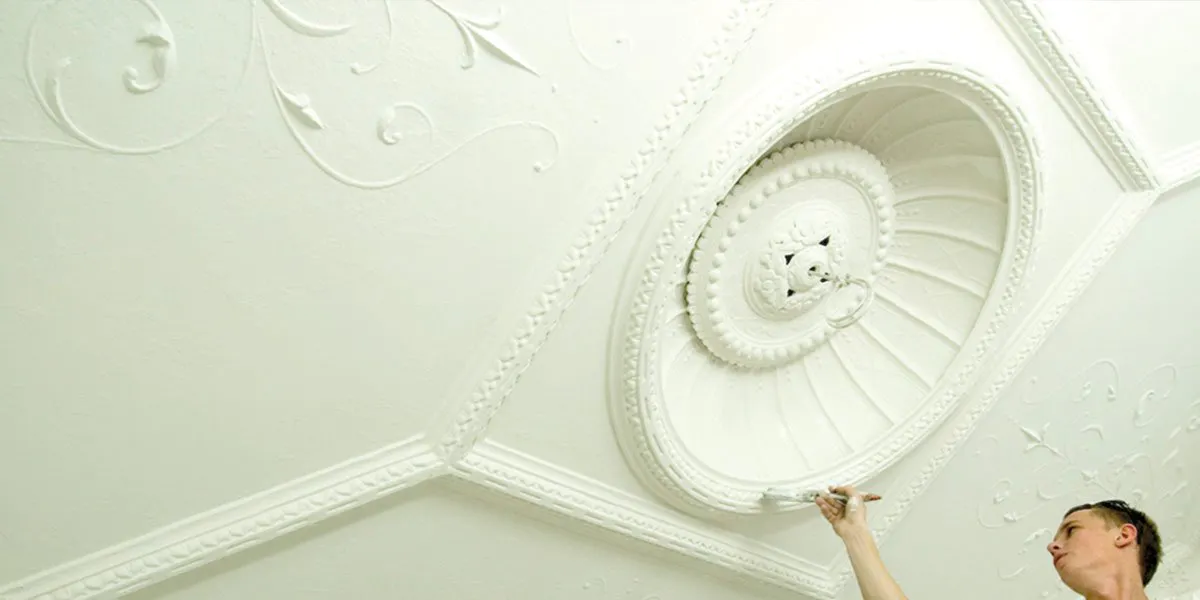
Modern-day challenges
One of the discrepancies between the houses of the past and the needs of today is storage. When these homes were constructed, storage was often relegated to outside. Houses were built on small posts, leaving a space between the ground and the floorboards which was used as under-house storage. Sections were typically bigger, allowing space for a separate garage and garden shed, which also provided plenty of storage opportunities. This meant that little importance was placed on interior storage – and consequently wardrobes.
Today, with section sizes shrinking and the number of possessions rising, storage inside the house is increasingly valuable. Many houses are in need of wardrobe creations (the term used to describe building out from an existing wall to create a wardrobe cavity), to enable residents to have a place to store their clothing. However, villa and bungalow style houses pose a particular challenge due to the style of the interior fittings and moldings.
A considered aesthetic adds value
The cardinal rule in renovations is “consistency adds value”. That is to say, a house that follows a determined style and has uniform fittings and detailing is ultimately more desirable than one that is mismatched (this is because a considered and consistent aesthetic shows attention to detail and a good sense of style, qualities desired by any homeowner). This is true of any style of house, but when you have invested in the character of a villa or bungalow, it makes sense that you would be especially interested in maintaining a style that is true to the original build.
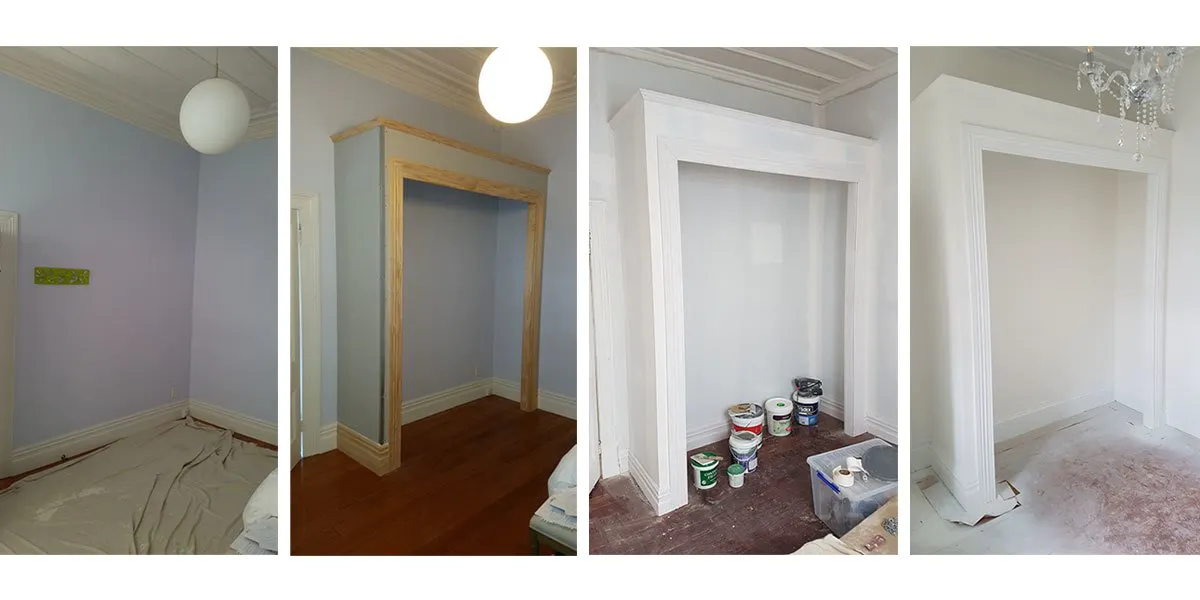
Boston’s commitment to consistency
At Boston we take into consideration the overall aesthetic outcomes for any home, and have a philosophy that wardrobe exteriors should always match the style of house they are built in, particularly in the case of villas and bungalows.
For this reason, our design consultants complete a “builder’s brief” as part of our service. This brief outlines technical details that need to be considered so that any building work required for your new wardrobe will result in a seamless finish. We can then either work with your own builder to complete the requirements or connect you with a tradesperson from our trusted network.
Your home is likely your most valuable asset, so it is important to always take steps that will lead to not just maintaining, but increasing its value. Over the past 30 years, we have had the pleasure of working with thousands of homeowners in Auckland, many of whom had original villas and bungalows to do just that. We pride ourselves in having achieved seamless results for storage solutions that complement the character of these classic Kiwi homes. If you have a renovation project that requires an experienced eye, get in touch with us to discuss.
Other articles
May 8, 2024
What’s happening in our wardrobe space: wardrobe design trends
We're diving into the top wardrobe trends that we see shaping the landscape of wardrobe spaces in Auckland
April 7, 2024
The value of wardrobe storage in multi-unit residential interior design
A well-organised space is crucial to a sense of serenity at home, so creating the ideal storage solutions in multi-unit residential builds needs an expert hand.
March 8, 2021
How much will a new wardrobe cost?
Without a doubt our most frequently asked question, answered in great detail

